Farragut class Destroyers (1934)
 US Navy Fleet Destroyers (1933-47):
US Navy Fleet Destroyers (1933-47):
USS Farragut, Dewey, Hull, MacDonough, Worden, Dale, Monaghan, Aylwin
Starting anew: The Farragut class
The Farragut class destroyers marked a turning point in ship design for the United States. They were the first design studied since 1917, and first destroyer type since the Washington Treaty signing and application in August 17, 1923, cloturing for good the mass-construction of the famous “four pipers”, emergency destroyer class of WWI.
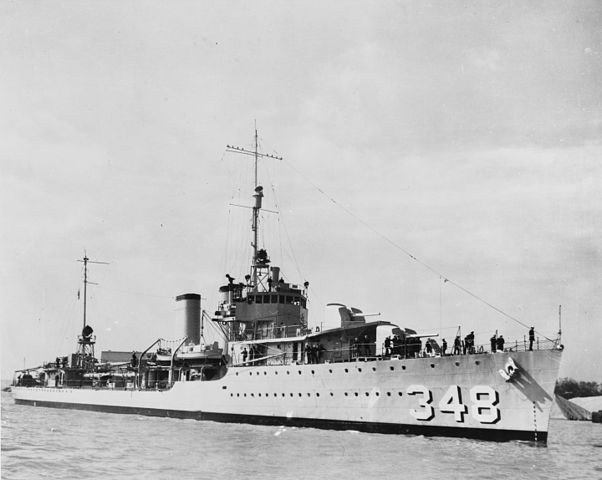
The “four pipers” Inheritance
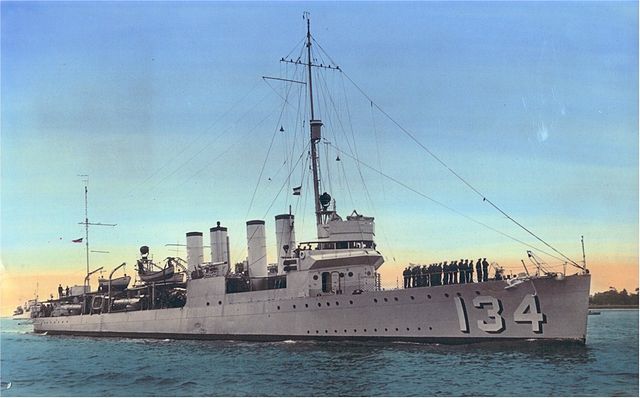
USS Crowninshield (DD-134) in 1939
At war in April 1917, the USN rapidly expanded its capabilities, to follow new battleships, but mostly to escort merchant traffic contested by German U-Boats in the first battle of the Atlantic.
These “four stackers”, “flush deckers” among other nicknames were the Wickes (111 built) and Clemson class (156 built). Two separated series for a grand total of more than 260 identical vessels, which were the culminating points of previous designs such as the 1916 Caldwell class.
They were designed with much simplifications in mind, inherinting most design aspects of the Caldwell, notably their flush-deck hull.
They were caracterized by the same four 4 in (102 mm)/50 caliber guns in lozenge arrangement (two amidships, one aft, one forward), a single 3 in (76 mm)/23 for AA defence and no less than twelve 21 in (533 mm) torpedo tubes in two triple banks installed on either side. The Wickes were just larger for more range, faster at 33 versus 32 knots. The Clemsons were essentially a minor redesign with greater fuel capacity for extended range.
The last of these were completed in the summer of 1922, whereas the Naval Washington Treaty was already signed (February).
Washington Treaty Provisions on Destroyers
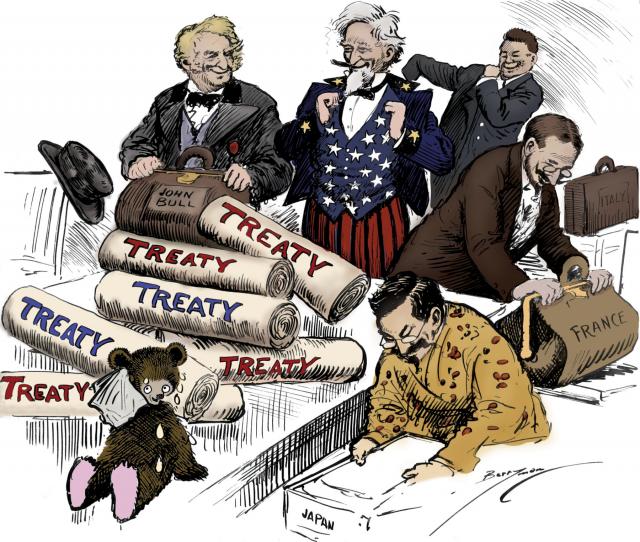
Importantly in this treaty was expressed, page 73 under “auxiliary crafts” where layed Destroyers and Flotilla Leaders, in c., that “Destroyers and flotilla leaders 12 years of age from date of completion may be replaced by new construction. The keels of such new construction shall not be laid until the tonnage it is intended to replace is 11 years of age from date of completion”. Therefore all the “four pipers” completed in 1918 could be scheduled for replacement already in 1930, but the bulk were scheduled for 1933, setup as the starting point for any new construction.
The treaty introduced no provision in terms of individual tonnage or maximal armament for that matter, otherwise than a global tonnage, which mostly concerned capital ships.
London Treaty Provisions on Destroyers
The London treaty was scheduled to expire in 1936, and thus, after years of practices to go around most of the clauses, a new treaty was worked on to be proposed and signed to the same naval powers, negociated at London, and this time motivated by the recent wall street crash of 1929 and subsequent world’s financial crisis. In part fuelled by a vehemently pacifist public opinion expressed in Geneva, many wanted to harden the treaty several fold, not only prolongate the capital ship ban but making it indefinite, and also impose a ten years moratorium on cruisers, while imposing severe restriction on destroyers. Eventually, signatories only agreed on maintaining the ban deadline to 1936 but agreed to cap heavy cruiser construction (provisional ban on 8-in guns cruisers, with replacement clause), albeit freeing light cruisers from any limit up to 10,000 tonnes as defined in 1922.
In article 15 was specifically expressed for the first time that “Surface vessels of war the standard displacement of which does not exceed 1,850 tons (1,880 metric tons), and with a gun not above 5.1 inch (130 mm) calibre.” This adressed in part notably Japan creating its own over-armed “special type” in 1926 (the Fubuki class -1,750 long tons standard, 4x 5-in guns, three triple TT banks), avoiding a naval race in that category. Still, 1,850 tonnes gave some leeway to all signatories, but this excluded “destroyer leaders” (France for example went on with classes of 2,500 tonnes like the “Le Fantasque” class laid down in 1931, and both Italy, UK and the US looked at similar designs).
The US thus had the intention to built both classes, standard fleet destroyers under this tonnage, and destroyer leaders above. Between the Washington replacement clauses and a global tonnage of 150,000 tons (circa 85 destroyers, less with 2,000+ tonnes leaders), there was some leeway to rapidly ramp up production of several classes, even with the precision in XVI.4 that destroyer category should not reach 16% of the allowed total tonnage in vessels over 1,500 tons”, and that “no other destroyers exceeding 1,500 tons (standard) shall be constructed/acquired this reduction 16% has been effected”. In the next article it was also precised that up to 10% of the ‘cruiser’ category may instead be built as destroyers, leaving the admiralty some though about substituing heavier destroyer leaders.
Design Development
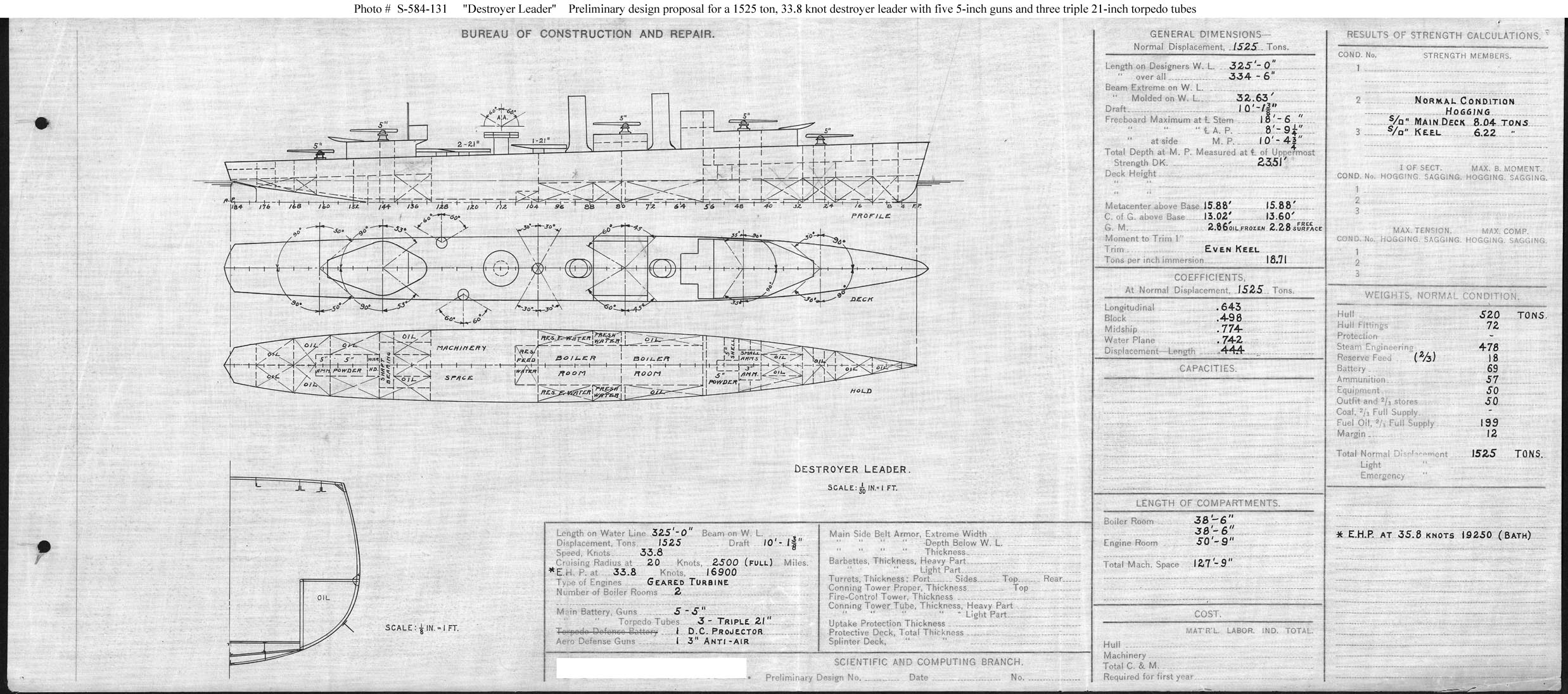
DD-191 class project for a 1918 alternative flotilla leader, 1,525 tonnes, BuC&R design study (unknown exact date). Note the rather modern artillery disposition on superfiring pairs in the axis, reminiscent of British V-W classes. It however had three triple bank, one axial forward, two aft in échelon. Instead DD-191 was ordered as a regular Clemson class, USS Mason. But the design looks quite modern for its time.
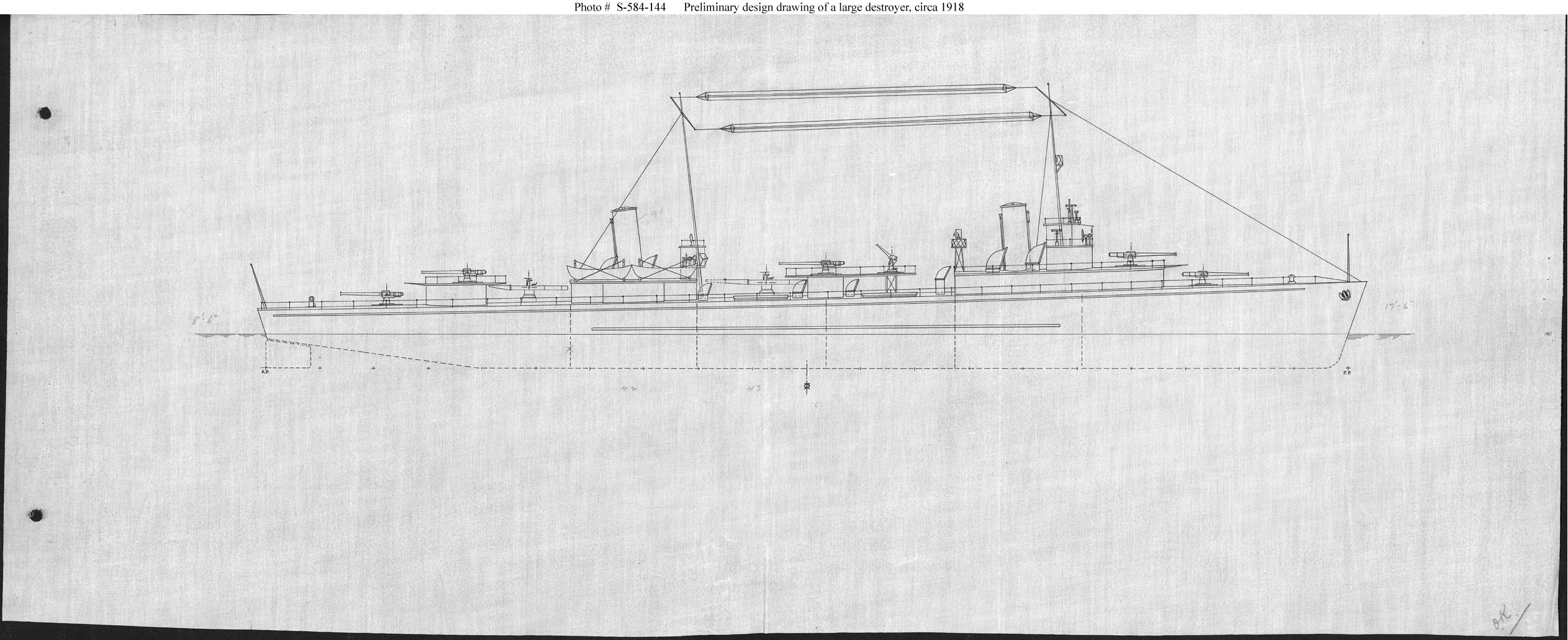
A prelimnary study for a 1918 “large destroyer” design. Also modern with four superfiring 5-in guns fore and aft and a fifth amidhships. The same platform houses a 3-in AA gun. Without top view it’s impossible to determine the nature and location of the torpedo tubes banks. Note also the two funnels far apart.
Like for peacetime cruiser or capital ship, the admiralty soon agreed on an incremental development, with six standard fleet destroyers for each on average and four for flotilla leaders.
The Interwar Design Debate started much earlier than 1930 however, over a large flotilla leader type similar to the 1918 British V & W Class.

The 1919 2,200 tonnes destroyer leader design, with a forecastle, superfiring guns, which looked quite modern for its time.
By February 1919 already, a 2,200t design standard with five 4in guns, all centerline, and the same twelve torpedo tubes in wing banks was looked upon. The solution of wing bank answered potential problems perceived with axial torpedoes and allegedly prevented any over excited captain to fire all of these at once.
This 1919 design was not popular, most seeing it more as an offensive weapons like torpedo boats of old rather than a fleet and anti-submarine escort. Captains still expected to surge against enemy battlefleets using the Battle of Jutland as model.
F.S. Craven design (1920)

src: JSTOR “To the Edge of the Possible: U.S. High-Speed Destroyers, 1918-1953: Part 3, Chronological Development”
In 1920 however, Lt. Commander F.S. Craven submitted a design to the General Board encompassing most aspects underlines by destroyer captains, active and retired. It looked a bit dated, with a turtle-back forecastle believed to procure increased speed in smooth seas, and six 5-in guns in three triple mounts, a triple axial torpedo tube bank and two triple tubes on the centre line, aft of the rear funnel/aft deckhouse, plus exra free launch torpedoes on the fantail and a single 5-in AA gun. He saw it as a “disposable tool” to be thrown at an enemy fleet, unloading all torpedoes at once an escaping while firing those in the stern tubes.
Surprisingly, this design gained support, even ended approved by the CNO office in July 1920. The General Board tried to secure funds to built five FY1921, vetoed by the Congress. Between peacetime desarmament mood and the Washington treaty to the point of being launch, this was not the right moment, congressmen seeing the huge fleet of flushdeckers, some just completed, as perfectly sufficient without going into a new costly “adventurous design”.
1927 1400t fleet destroyer
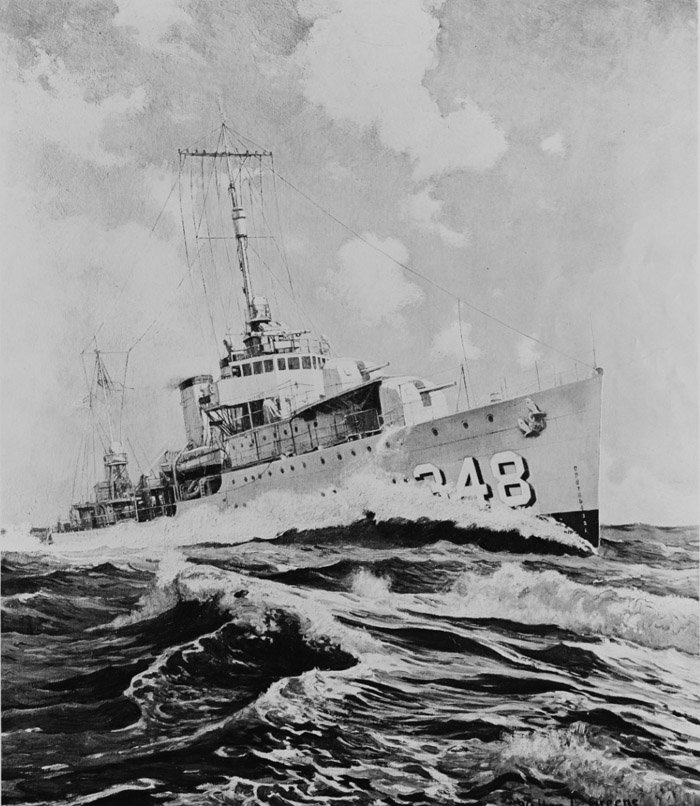
Artist rendition of the Farragut class by Walter L. Greene.
In 1927, another new design was developed as a “standard”, fleet destroyer based on a 1,400t standard displacement with as specified, twelve torpedoes (two sextuple mounts !) on the centre line, and four 5-in guns, plus high pressure steam boilers. But this design study never got traction. Some aspects were liked by the admiralty, others not and there were in particular doubts avout the sextuple torpedo mounts, between complexity and weight. This never has been done, and at best, the IJN’s Shimakaze class introduced a quintuple bank in 1942, as well as the USN Sumner class in 1943. This was more realistic on a 2,500 tonnes displacement for topweight reasons.
Later in 1927 work began on a new destroyer leader design. This time the design teams produced a rangel of eight designs for ships of wildly different sizes, from a 1,421t destroyer to a 2,900 super-destroyer inspired partly by a new generation of French and Italian large destroyers. In 1928 the General Board designed on an intermediate set of specifications – no more than 1,850t displacement, four 5in/51 single purpose guns, twelve torpedo tubes and an endurance of 6,000 miles at 12 knots. This design didn’t offer much improvement over the Clemson class other than an increase in range and the move from 4in to 5in guns.
Post-London discussions
In April 1930 the London Naval Treaty was signed and did not imposed limits on destroyer in global tonnage, but still fixed an indovidual tonnage limit of 1,850 tons, macimal caliber of 5.1-in (130 mm) in accordance fo French Destroyer caliber. The US Navy was however capped to 150,000 tons of destroyers with 16% only authorized to be over 1,500 tons of light or standard displacement, which conformed the US admiralty in her new destroyer design basic attributes.
Two competing visions soon emerged:
-One faction wanted to built two types of destroyers, between large fleet leaders at 2,400 tons with a much heavied gun battery and capable of 28-30kts, alongside smaller fleet models capped at 1,100 tons standards but capable of 40kts with an emphasis on torpedoes.
-The second faction advocated for a single, versatile fleet type with enough range to travel across the Pacific and deter any Japanese expansion on the Philippines. This view fit a “universal” 1,500t standard type more in accordance to the Treaty and simplifying costs and maintenance. In fact this was also to gain more traction with the Congress, perhaps more reluctant to built costly “super destroyers” on one hand in peacetime, or useless models for the pacific on the other in case of war.
1930-31 designs
This, the Construction & Repair Bureau ((BuC&R) proposed from this three designs:
-Standard destroyer 1,375t
-Standard destroyer 1,500t
-Destroyer leader 1,850t.
They all shared the same battery of 5in/25 gun, more usable that the heavy 5in/50 gun once proposed. Of course they all adopted a raised forecastle and the artillery was axial and in superfiring positions.
-The 1,375t was to carry 16 torpedo tubes in four axial quad mounts, two either side for a full broadside of 8. This took quite some space on the beam.
-The 1,500t design had three axial triple mounts, 9 torpedo broadside.
-The 1,850t leader also had two axial quadruple mounts, and ideally four twin turrets.
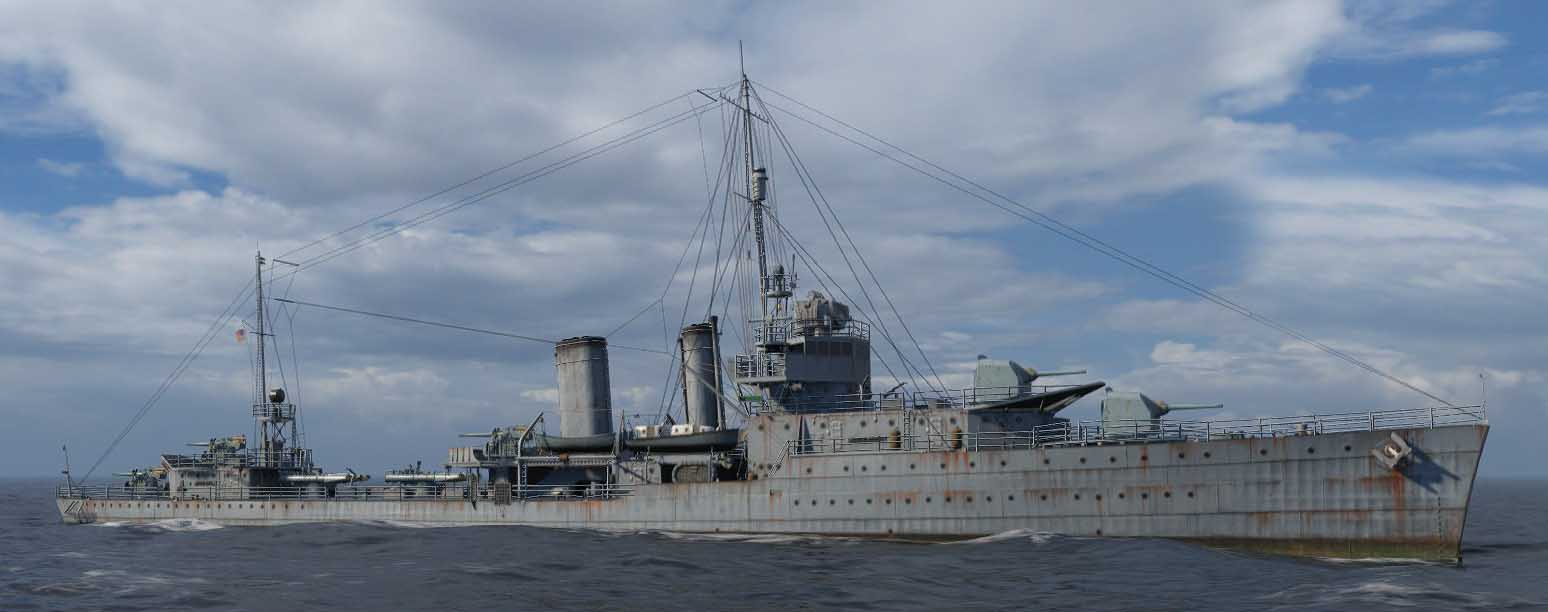
Wow’s rendition standard view
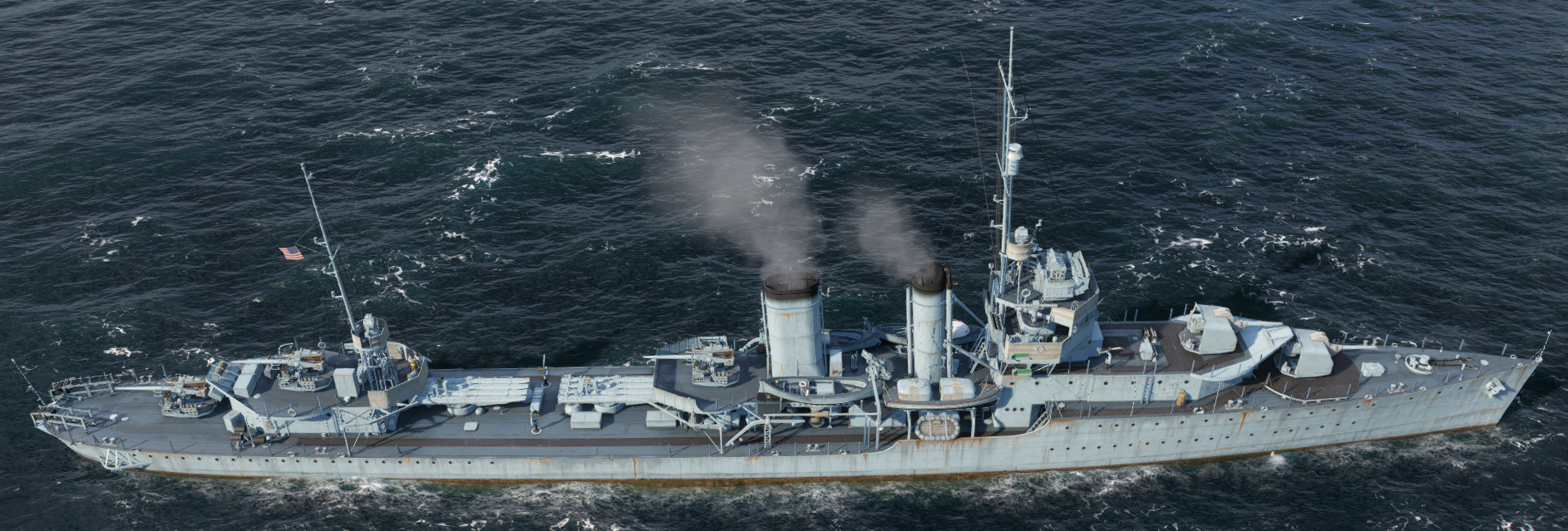
Wow’s rendition, 3/4 view
Eventually the 1,500t design received most appraisal for its larger torpedo capacity, and ultimately led to the Farragut class. The 1,850t leader was further developed and ended as the Porter Class Destroyers, so both factions in the end “won”. The first lost its “light destroyer” (partly based on the ground that achieving 40 kts on this tonnage was unrealistic), but still had their leader. The other faction won its 1500 standard fit for Pacific Operations.
C&R started to produce in January 1931 a new, more refine 1,500t proposition in January 1931 with a standard displacement reevaluated at 1,725t, armed with two single 5in/38 DP guns in a forward superfiring pair, but also twin 5in single mounts on either side of the aft deckhouses, six in total, plus three triple torpedo tube, all axial (centre line) which was rejected outright by the General Board. The latter proposed instead five alternative layouts, advocating for only four, but better protected 5-in DP (dual purpose) guns and still three triple torpedo tubes in axial and side banks to shorten the hull and making it lighter. The Secretary of the Navy wanted a five guns, two quad torpedo tubes design, and like the Board compromised with just the two foward guns actually shielded.
1932 Specifications
Meanwhile, other “little hands” made a remarkable compilation of more grounded specifications. The list of desired improvements went directly from operational experience, with the Wickes and Clemson classes. It spanned over ten years was long and comprehensive. Captains notes were complied into the following general fields of complaints:
1-The pointed sterns deeply dug into the water and increased turning diameter ;
2-Flush deck designs provided a cheap, simple construction with hull strength, but proved wet in high seas ;
3-Cruising range on both the Wickes and Clemson classes was inadequate ;
The first point was adressed with a new transom stern, a brand new design that was testing in basin, and the second with a return to the raised forecastle, already agreed by all and designed in 1919 already. It was however far higher than prewar designs and more in tune with the punishing north atlantic conditions.
For the third point, The Clemsons partly solved the range issue by having wing tanks installed, high mounted and proving a wing point since they were unprotected. The new design was to expand the range and havning protected tanks to reach 5,980 nautical miles verssu 4,900 nautical miles for the Clemsons. Outside of these points, an ibcrease of performance, also noted akthough 32-33 knots was still “comfortable” in 1930, steady improvements in boilers and steam turbines technology since a decade promised more compact machinery tet more output. It allowed a greater speed and just two funnels whihch incidentally cause less drag.
This data effort was praised among others by Rear Admiral Emory S. Land, at the head of BuC&R, when communicating with the General Board of the admiralty: He comparing the new Farragut class in design in 1932 with the Wickes and Clemson classes seeing that the first was:
-3.3 knots faster.
-Double the general metacentric height resulting in greater initial stability.
-25% more armament with 5 axial main guns rather than four in positions only allowing triple broadside.
-35% more firepower due to the new 5 in/38 caliber guns Mark 12 (previously 4 in/50).
-Now all 8 torpedo tubes were on the centerline, for a full broadside either side.
-Guns were now fed by power hoist from the magazines, safer and quicker.
-Hey had a much higher freeboard with much better sea-keeping.
-Radius of action increased by 450 nautical miles (830 km; 520 mi).
-All this was done on a mere 22% rise in displacement, which was worth the past decade of advancements.
Final Design of the class
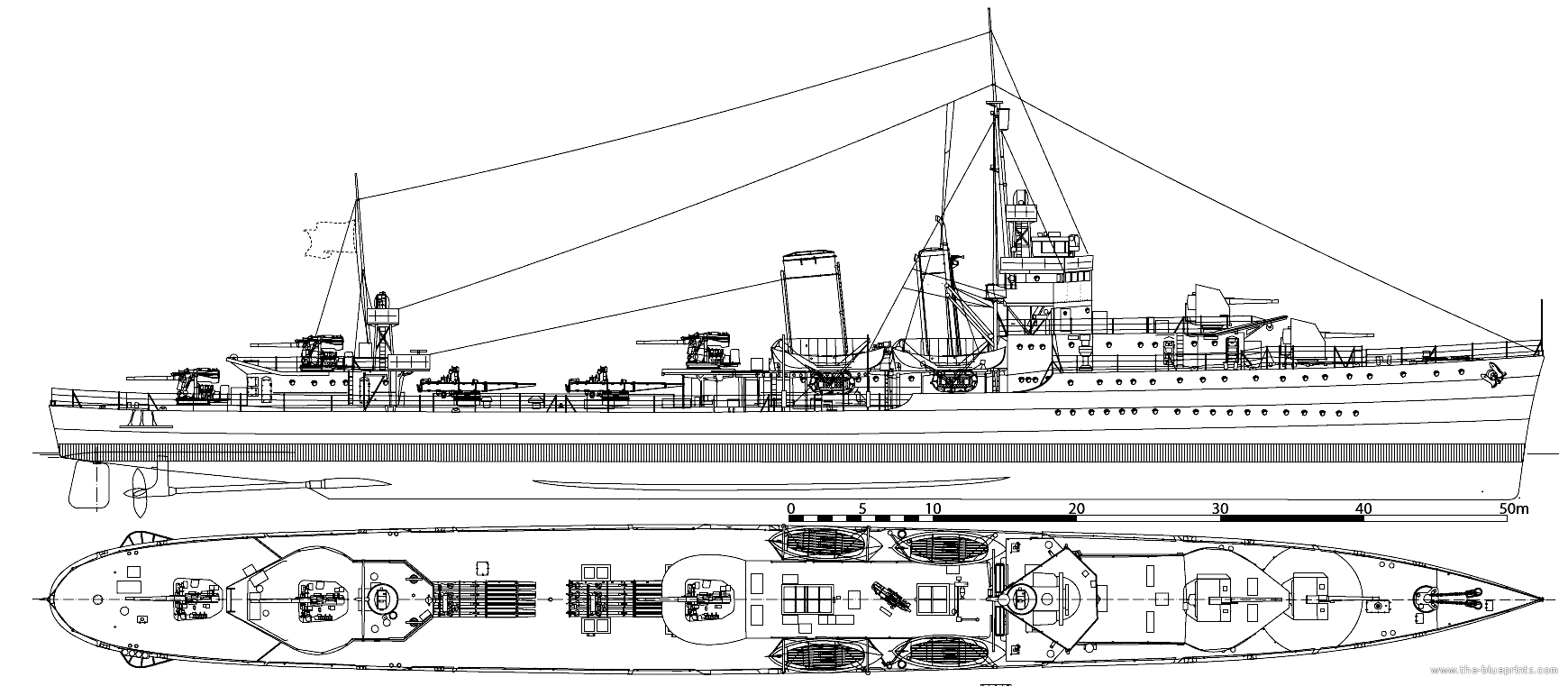
2-view details plan from the blueprints.com, reconstituted from original plans (cannot be found, possible not digitized yet).
Assuredly, the new DD-348 design was encompassing many design evolutions, starting with the forecastle, without knuckle, prolongated by two walls. The whole bow was raised considerably for a start, ensuring better seakeeping. In addition as suggested in 1930, only the forward main superfiring guns were protected by shields, which also acted against sea spray in heavy seas. All three aft guns were left without protection. It should be noted that a fifth gun was reserved in European navies, traditionally to flotilla leaders. “Standard” fleet destroyers only had four, plus a smaller dual purpose.
The profile was taller overall, and the bridge was no exception. It sat one level higher above the superstructure, above the chart room. It was prismatic but not like previous Wickes/Clemsons, with a flattened section forward, offering good peripheral vision with classic squared windows. The bridge wings were rectangular and went to full beam, but the upper open bridge deck formed the outboard corners of this prism. There were two morse signal lights on both main bridge wings corners. The signals storage bin was located aft of the structure, close to the foremast.
There was also the usual open bridge above with the main coincidence rangefinder and telemeter sitting above. The tall foremast was located at the dying end of this prism, composed of a single pole, in part supporting the derrick on top of which was located the formward projector platform. An old fashion whaler style lookout “bucket” was located almost atop the mast. Radio cables went downards to the mainmast aft.
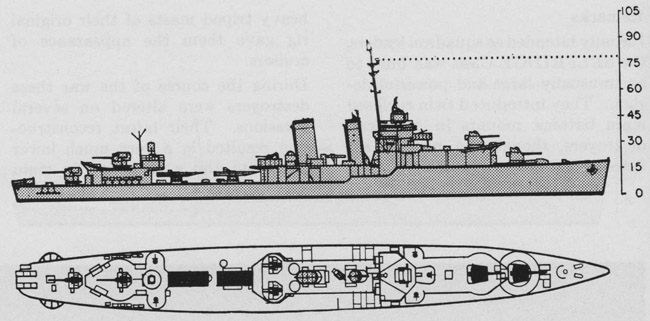
ONI recognition drawing
The aft superstructure, which continued the forecastle to amidships, supported the only two squarish funnels, the aft one being truncated into a model twice as large as the forward one, rectangular and not round, which was more rational but odd. Four service boats were placed on davits on either side, and inflatable boats were suspended at the same locations, below. Immediately aft of tis structure was located the main N°3, unprotected. Then came the two quadruple torpedo tube banks, without separation between them as customary on European designs, generally were sat the AA gun platform. The quarterdeck structure aft supported a platform with the two torpedo tubes rangefinders, then a derrick with the aft projector, the mainmast, and gun N°4.
Seen from above, the hull had no flat section. The greatest beam was located a bit after N°3 gun amidship, flare was very limited and the forward deck was rather narrow, but broader aft, rounded seen from atop, but it had a knuckle to transition into a transom stern of sorts. That was new compared to previous designs and the result of many calculations to master wake turbulences. Engineers wanted the stern wave sortie to be as reduced as possible, notably to not loss buoyancy and “grip” for the proplellers. Water density was essential for an optimised thrust. The process that led to this shape is well detailed in JSTOR “To the Edge of the Possible: U.S. High-Speed Destroyers, 1918-1953: Part 3”.
Hull and general design
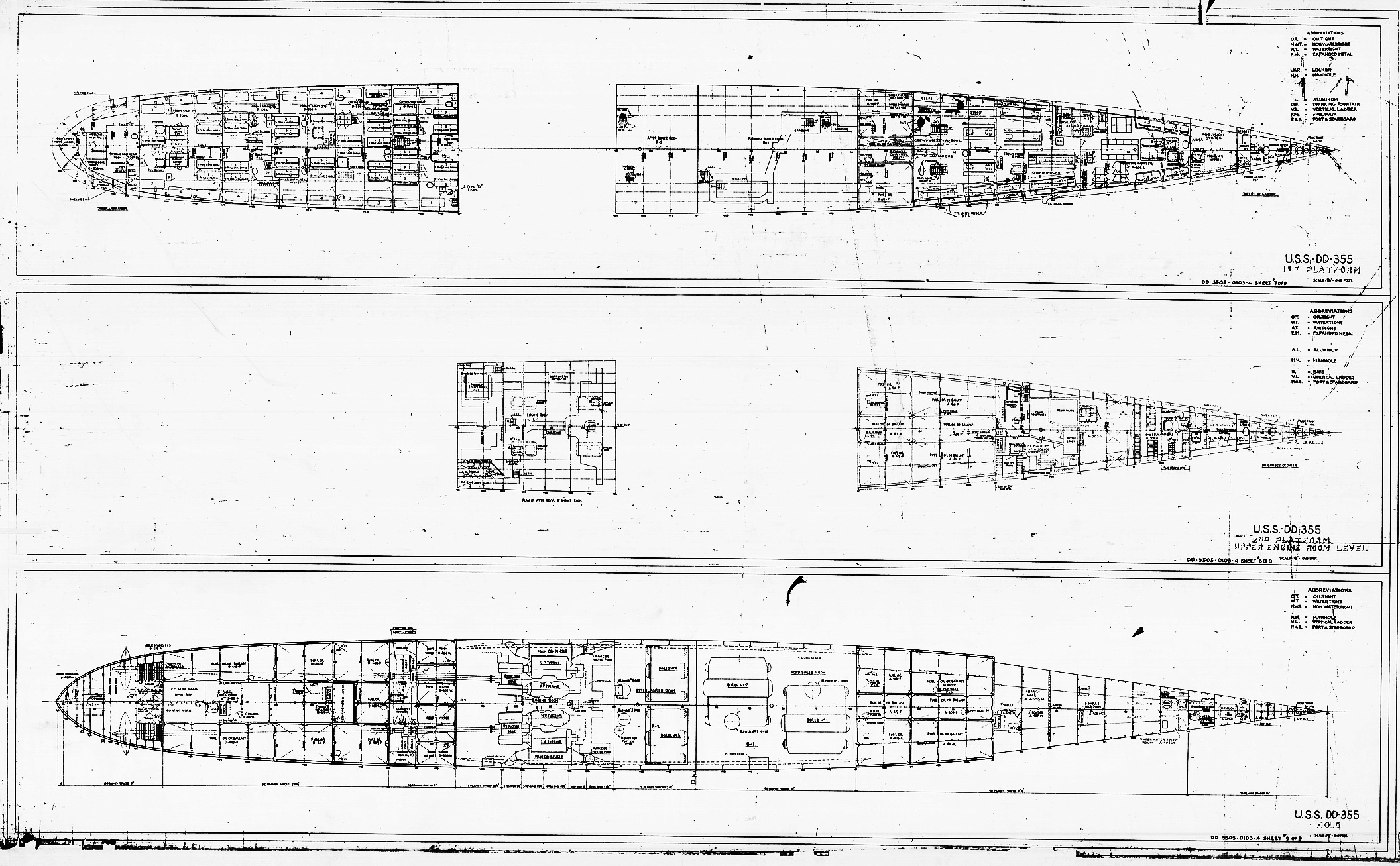
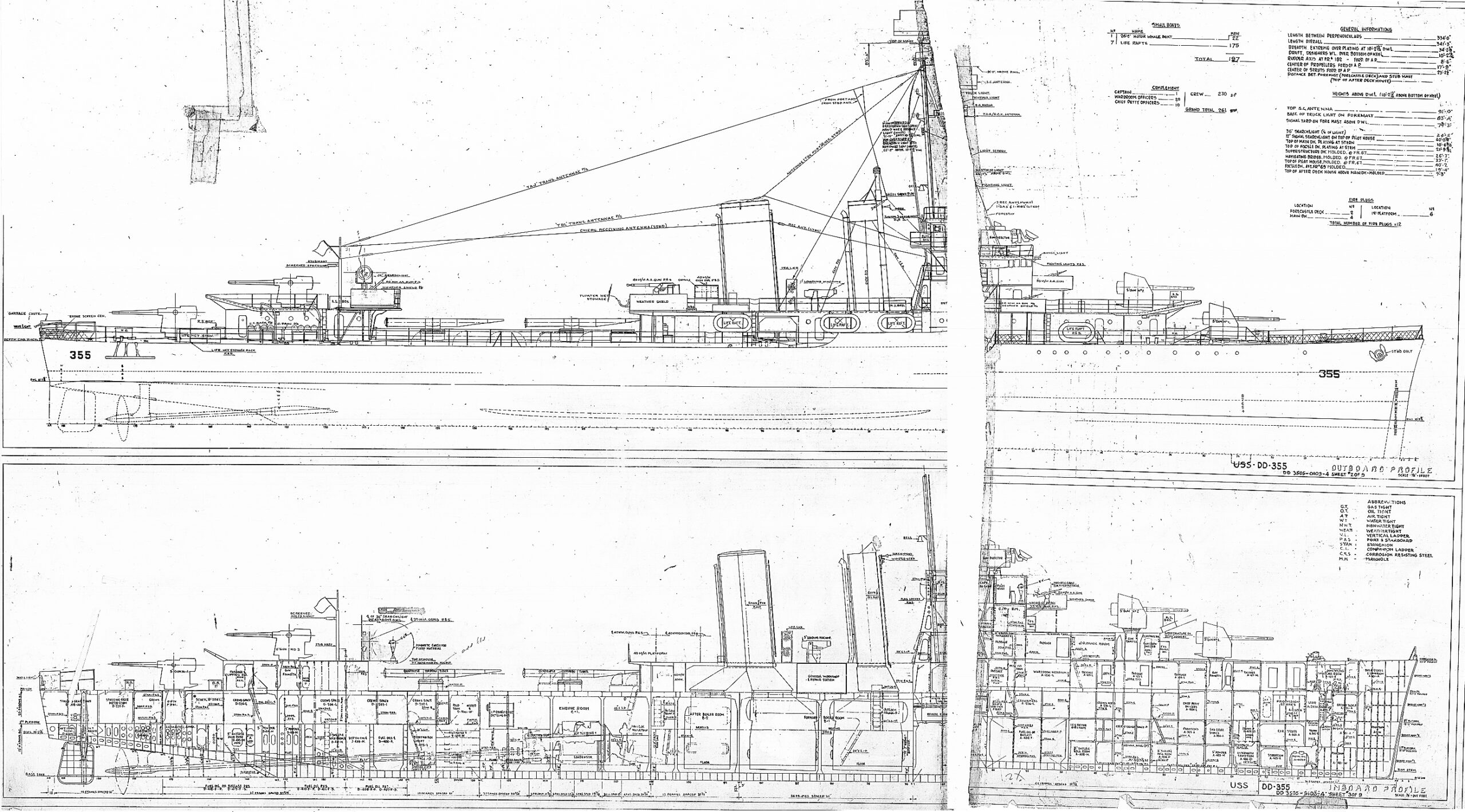
USS Alywin, plans, outboard profile (damaged unfortunately) and deck plans down to the machinery.
The new hull was based on a 1,365 tons standard displacement (so leaving a margin to install new equipments up to 1,500 tonnes) and reached 2,064 tons fully loaded.
It was however still narrow, 341 ft 3 in (104.01 m) long overall for a beam of 34 ft 3 in (10.44 m) -classic 1/10 ratio- but with a very tall forecastle, and a draft of “just” 16 ft 2 in (4.93 m). Still, metacentric height was considered good. But as said compared to European designs, there was very little flare, the forward section was quite narrow. This did not changed much throughout the following design, up to the Fletchers. The same generic hull shape was kept all along.
Powerplant

Propellers, rudders and stern as built (via navsource).
The Farragut-class benefited from ten years of advances in machinery design, boilers and turbines improvements: Steam pressure and temperature went from from 300 psi with saturated steam to 400 psi (2,800 kPa) now with superheated steam to 648 °F (342 °C). This new system increased turbines efficiency and improved the range considerably. Indeed, it was the first use of superheaters in a US destroyer. Economizers used boiler exhaust gas to preheat the feedwater, before it entered the boiler, thus also sparing fuel to boil the water.
The turbines were Parsons-type (licence built) reaction turbines, by Bethlehem Steel. They were divided into a high-pressure section, followed by a low-pressure section, but with refined components, sepcially gears and fans to take the most of the superheated steam. The turbine was then mated to a common reduction gear, drive the main two shaft. This was the general arrangement reused on all US Navy vessels. There was still however the single-reduction gearing of the previous class, whereas from the Mahan class onwards (next standards) and following, it was swapped for double-reduction gearing, making turbines more compact.
Armament
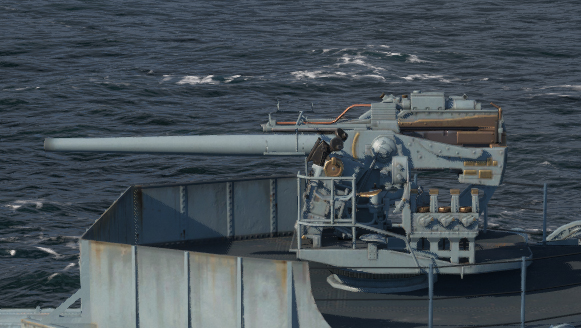
Wow’s rendition, Farragut’s 5-in/38 N°3 closeup
For a “standard”, the Farragut class was rather well armed, with five rather than four main guns. The caliber was standard for the time, but the sacrifice of the usual dual-purpose gun meant they were armed like WWI destroyer leaders. For comparison, the British A-B class destroyers only had four 4.7 in (120 mm) guns, but 2-pdr AA guns. Instead, AA was limited to four standard liquid-cooled 12.7 mm browning machine guns. Against 300 kph biplanes in 1933-34 this seemed already barely adequate. This was upgraded as soon as practicable.
At a time also many destroyers had triple torpedo banks. The choice of quadruple ones was also new (compared to the Clemsons), but it was the next obvious tendency in all navies. British A-B destroyers had such banks as the IJN. Fubuki class since 1926 already. And being axial, the full broadside was available on both sides.
As completed, these vessels were also devoid of any ASW weaponry. Anti-submarine means planned were to be a sonar and two DCRs ‘Depth charge Racks), but in wartime an increase of this capability with the installation of additional DCT (Depth charge Thrower) was planned, for what the deck had necessary reinforcements.
Main Artillery: 5x 5-in/38
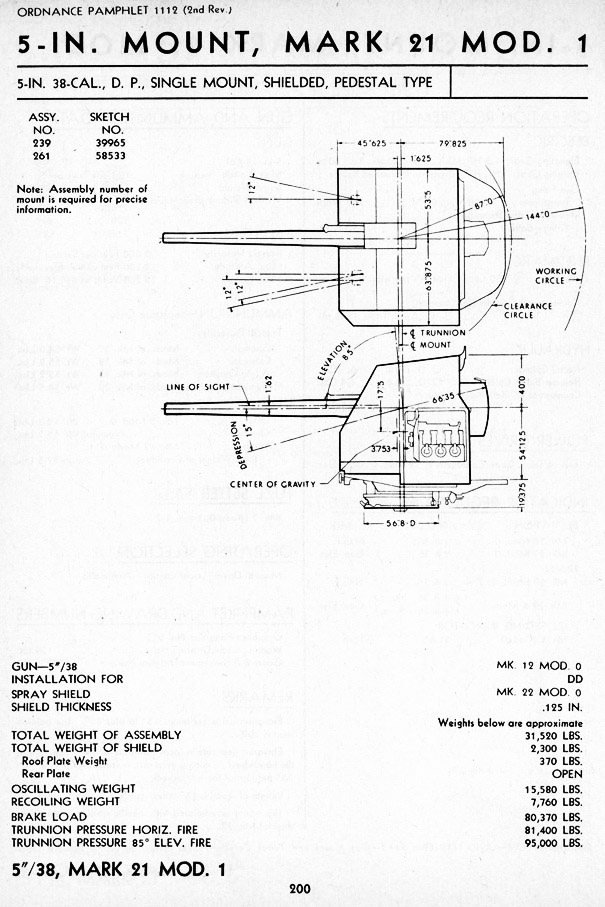
Mark 21 Mod 1 with the associated shield.
The 5-inches (127 mm)/38 caliber guns were a great classic, which replacd the 4-in/25 caliber of the previous Clemson class. The shells weighted almost double, so firepower had a net increase compared to previous vessels. This was asked to counter IJN destroyers like the Fubuki class, which had six of them in three twin turrets. The 5-in/38 was the first successful true dual-purpose gun in the USN, mid-length compromise between the older 5″/51 low-angle and 5″/25 AA gun. It was developed as the Farragut class were just started in 1931 and in service when they were launched in 1934. It ised a vertical sliding-wedge (Mk12 Gun Assembly) with a 15 in (38 cm) recoil, elevation up to 85° (and depression -15°), average traverse of 328.5 degrees and ideal rate of fire of 15 rpm. Each explosive shell left the barrel at 2,600 ft/s (790 m/s).
Fire control:
Anti-Aircraft Artillery
There was no secondary intermediate AA gun, thanks to the dual purpose capability of the guns. However it appeared later with the increased speed of all-metal monoplane that the AA capability was not longer relevant. At first, the four Browning 0.5-in/90 M1920 machine guns were possibly located on the wings. Their mounts does not appear on reconstructed plans.
In 1941, they were still there. However from may to September 1942, the USN pressed into service its first licence-built 20 mm oerlikon guns and eight 20mm/70 Mk 4 were installed in place of the N°3 main gun amidship, sacrificed. As the war progressed, when practicable, this was modified again with just three single 20mm/70 kept and the ones amidship replaced by two twin 40mm/56 Mk 1.2 Bofors which became the norm. By 1945 the standard was the same two twin Bofors, and five Oerlikon Mk 10. By that time, full displacement reached 2,307-2,335t, almost a thousand tons more than the original standard tonnage.
ASW equipments
As completed, the ship had no apparent depht charge racks. They were added in mid-1941, as the sonar. Each of the racks hold 7 depht charges, so 14 in all. No provision for more is known.
In early to September 1942, they also obtained four extra DCT K-Gun type (Depth Charge Throwers) for 48 depth charges in total, a substantial increase. They had two Mark 1 Mod 1 racks installed aft, these were versions of the original Mark 1 Mod 0, cut down to hold five Mark 6 or three Mark 7 Depth Charges. They became the norm for Farragut and following. The Mark 6 (1938) was a redesigned WWI-era Mark 3, weighting 420 lbs. (191 kg) with a 300 lbs. (136 kg) TNT charge, a sink Rate or Terminal Velocity of 8 fps (2.4 mps) and settings range from 50 or 300 feet (15 – 91 m).
Torpedoes
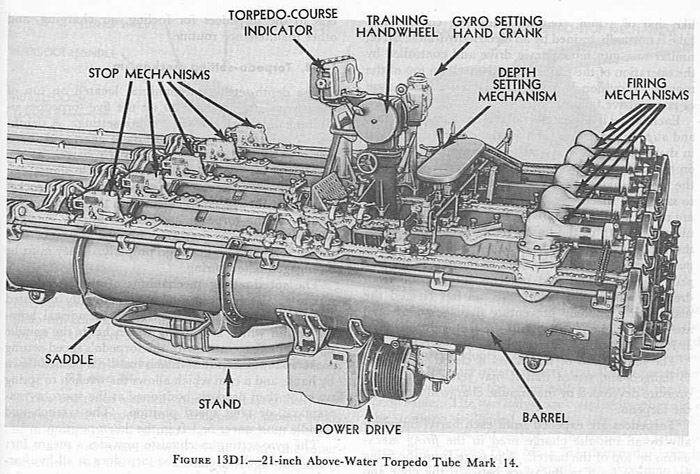
Mark 14 Torpedo Tube Bank for Mark 15 Torpedoes.
21″ (53.3 cm) Mark 15: In service from 1935, it replaced the 1938 Mark 13. It became the standard destroyer torpedo, replacing old stocks of Mark 11/12 used on the Wickes/Clemson and remained in service until 1944, with 9,700 mass-produced between 1940 and 1944. The Mark 15 Mod 0 weighted 3,438 lbs. for 22 ft 7 in (6.883 m) in lenght. it was powered by a Wet-Heater steam turbine and guided by the Mark 12 Mod 3 gyro. It carried a 494 lbs. (224 kg) TNT warhead on the base of three settings:
-6,000 yards (5,500 m)/45 knots
-10,000 yards (9.150 m)/33.5 knots
-15,000 yards (13,700 m)/26.5 knots
Fortunately it never suffered the same issues as the controversial Mark 14 used on submarines. It just did not hold the comparison with the infamous Japanese “long lance”.
Fire Control & Radars
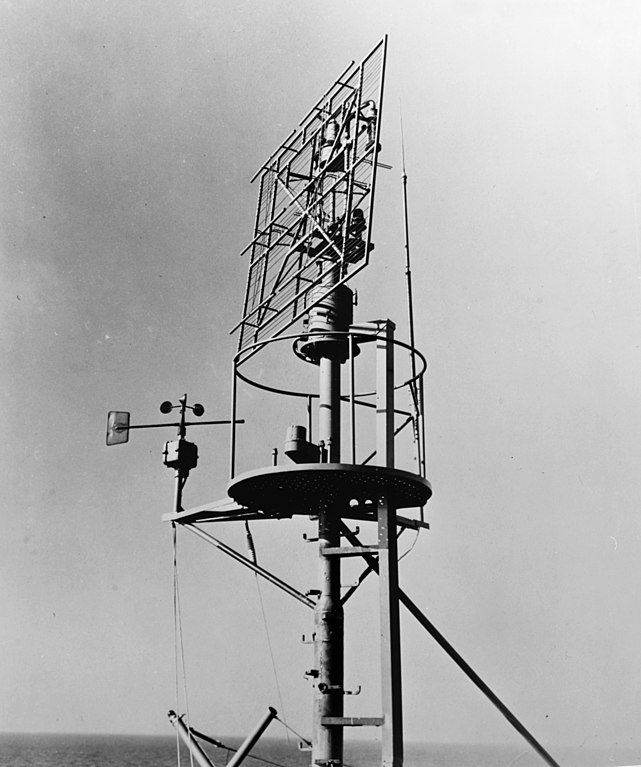
SC radar. A classic early warning radar with a range between 48 and 120 km (30–75 mi).
The Fire controls of a Farragut class consisted in a Mark 33 standard Gun Fire Control Systems (GFCS) installed on top of the bridge. The Mark 33 GFCS was power-driven and a less sophisticated version of the Mark 37 on larger ships.
It used the Mark 10 Rangekeeper analog fire-control computer mounted in an open director rather and not in a separate plotting room due to the lack of space. The Mark 33 was inaugurated by the Farragut class and used on the Mahan, Gridley, Bagley and Benham classes.
In 1944, it is possible the surviving ships had been upgraded to the Mark 51 Gun Director, not the larger Mark 58 Rangefinder.
As for radars, the Farragut class was equipped from 1941 by 1942 to 1944 depending on availability, with the common SC and SG as well as the Mk 12.22 radar.
At the end of the war, they were also upgraded with a new sonar, the QCA.
General Assessment
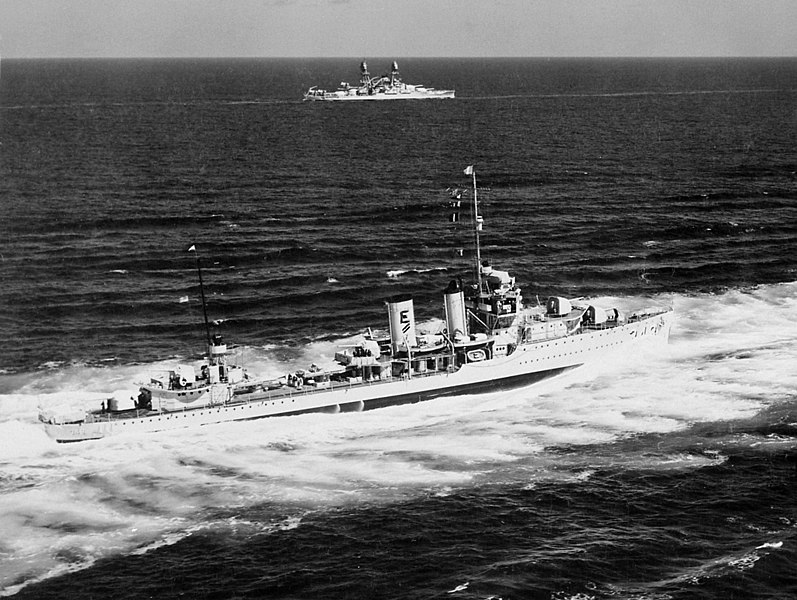
USS Farragut in September 1939
Due to their long service life from 1935-36 to 1946-48 these destroyers generated tons of reports and their advantages soon turned in part into more controversial issues as new classes were introduced. In particular, they were found considered unstable in heavy weather, and while turning. They bled speed while healing at an alarming rate, so much so captains succeeding in command soon had the habit of warning themselves not to manoeuver full hard rudder if practicable.
This issue was caused in part by their hull shape, tall superstructures, and unlike other more acute designs like the Porter class and following, completely rebuilt, war-time modifications made them even more top-heavy, while they stayed in their original state. Two in fact famously sunk in the December 1944 typhoon: USS Hull and Monaghan. It seems to some witnesses they seemed to roll even worse in 1943-44 than in their interwar years, and even in the calmest weather it was borderline dangerous.
The court of inquiry after the Typhoon in 1945 aknowleged that for the destroyer lost, the basic stability of the Farragut-class was “materially less than other destroyers”.
We have to remember here however that these were experimental designs, despite having almost ten years of reflexion. Only the London treaty speed the design up and before a ship could be built on a new hull shape and superstructure, apart probable metacentric height there was no way to figure aout its behaviour in the real world. The overweight issue was common to many other contemporary US designs of the time, notably the Pensacola and even the Northampton class cruisers.
But unlike the destroyer leaders, partly rebuilt, the Farraguts stayed “in their juice” with further additions and little effort to remedy their problems than the usual “handle with care”. It’s true also that none was lost in action: USS Worden was wrecked during an Aleutian operations in 1943, on uncharted rocks at Amchitka island. Hull and Monaghan 18.12.1944 were lost due to the aforementioned Typhoon off Luzon. MacDonough on 10.5.1943 was hit in a collision with USS Sicard and repaired for six months. They served in the Pacific and as for battle records, made nothing much remarkable. All were present at the attack on Pearl Harbor and Monaghan sank a Japanese midget submarine that day, opening the hostilities on the US side by the first IJN naval “kill” outside aircraft shot down.
Appearance – Camouflage Schemes & renditions

Old author’s profile, as commissioned, with a large forward identifier and original light grey livery.
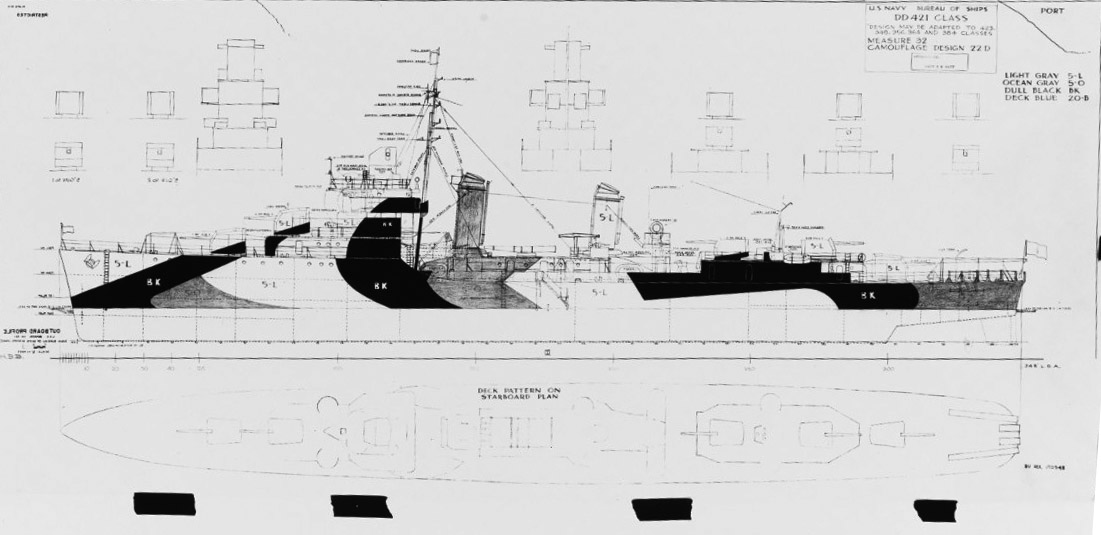
Measure 32, design 3D
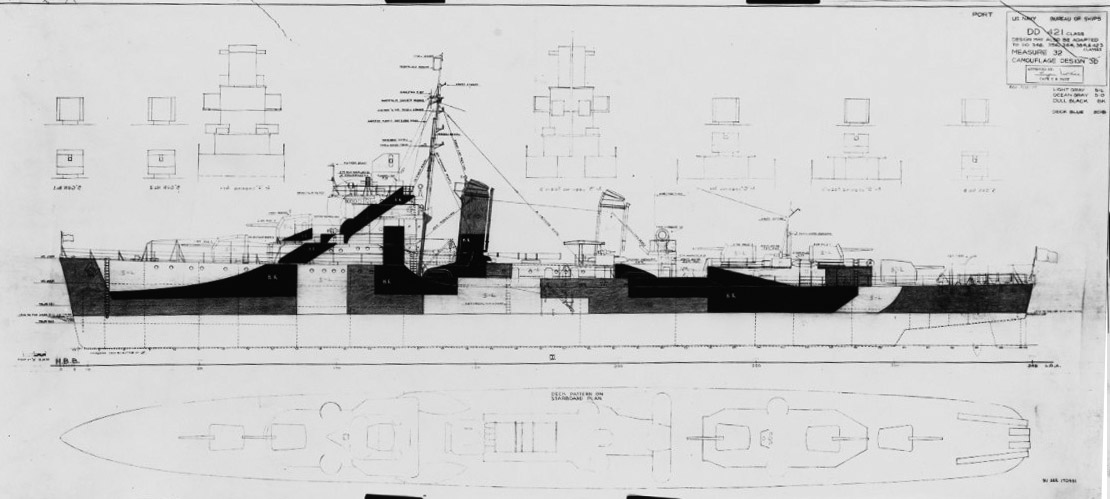
Measure 32, design 6D
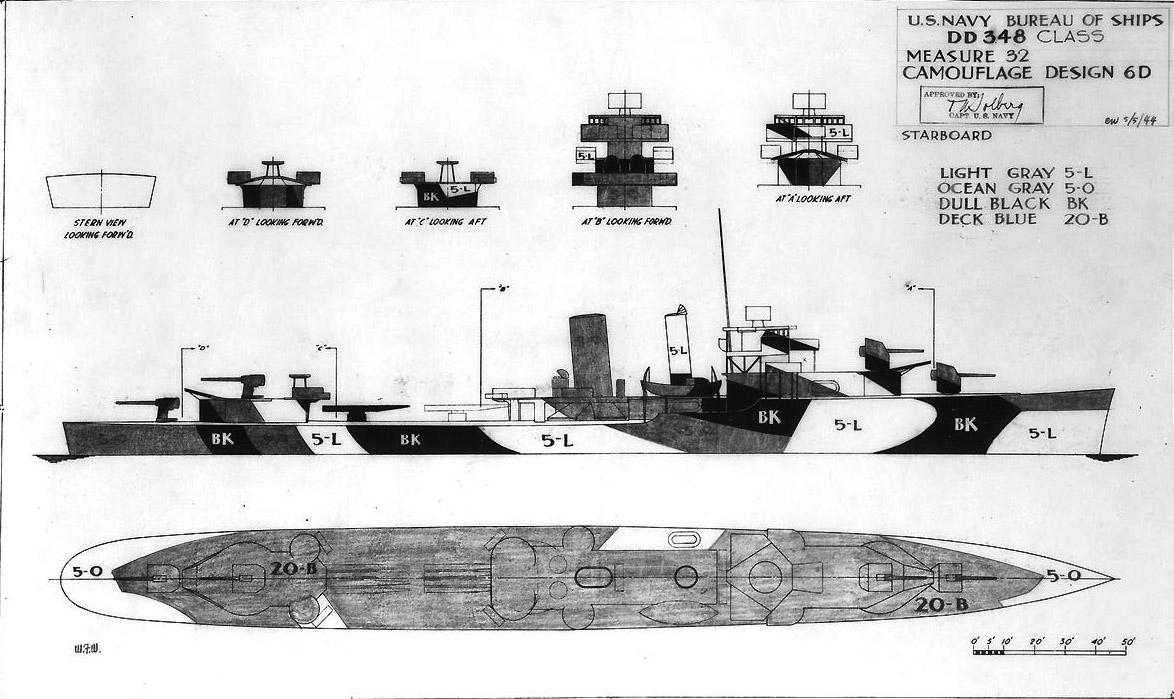
Measure 32, Design 6D
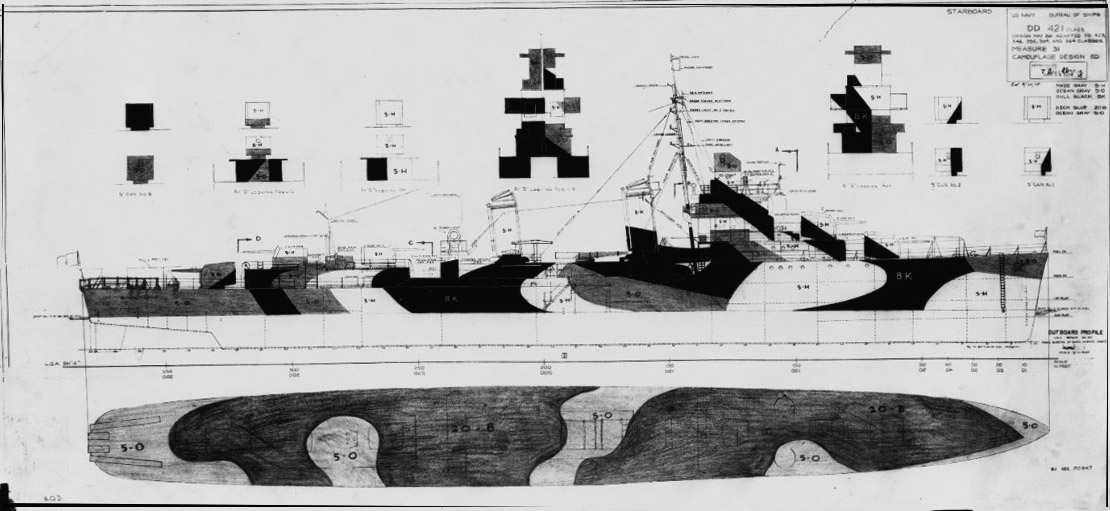
Measure 31, Design 6D

Measure 32, design 32D

USS Farragut, 29 September 1944
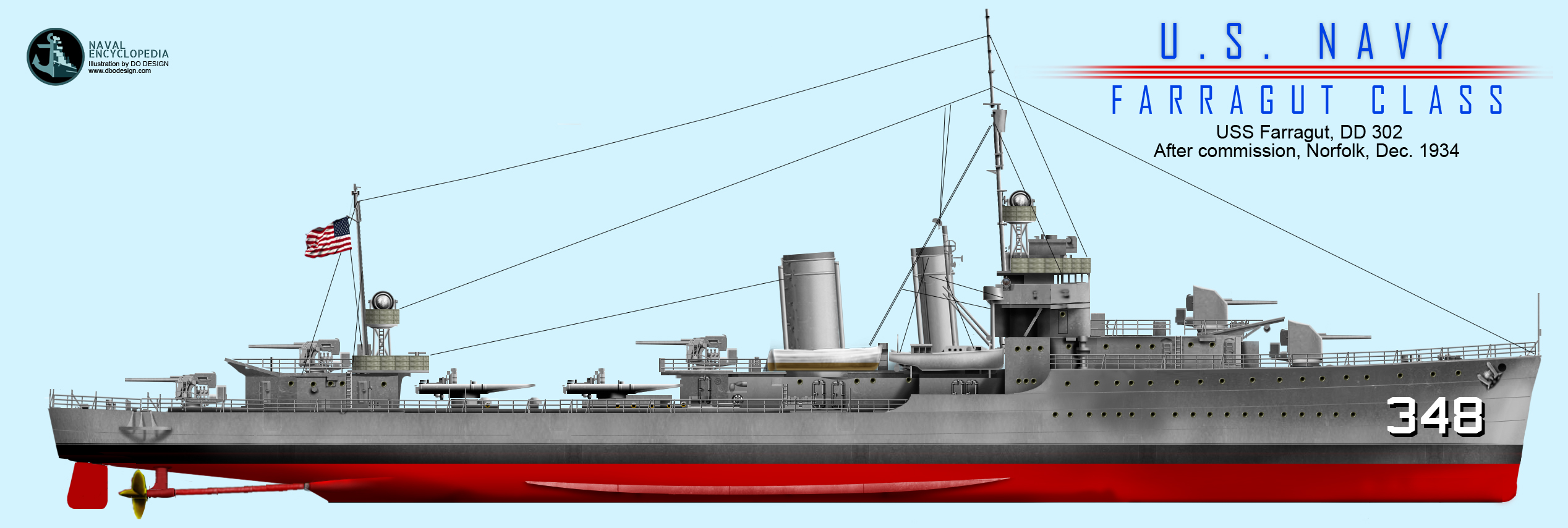
Author’s HD rendition of USS Farragut as completed, off Norfolk during her extended trials and developmental tests in December 1934
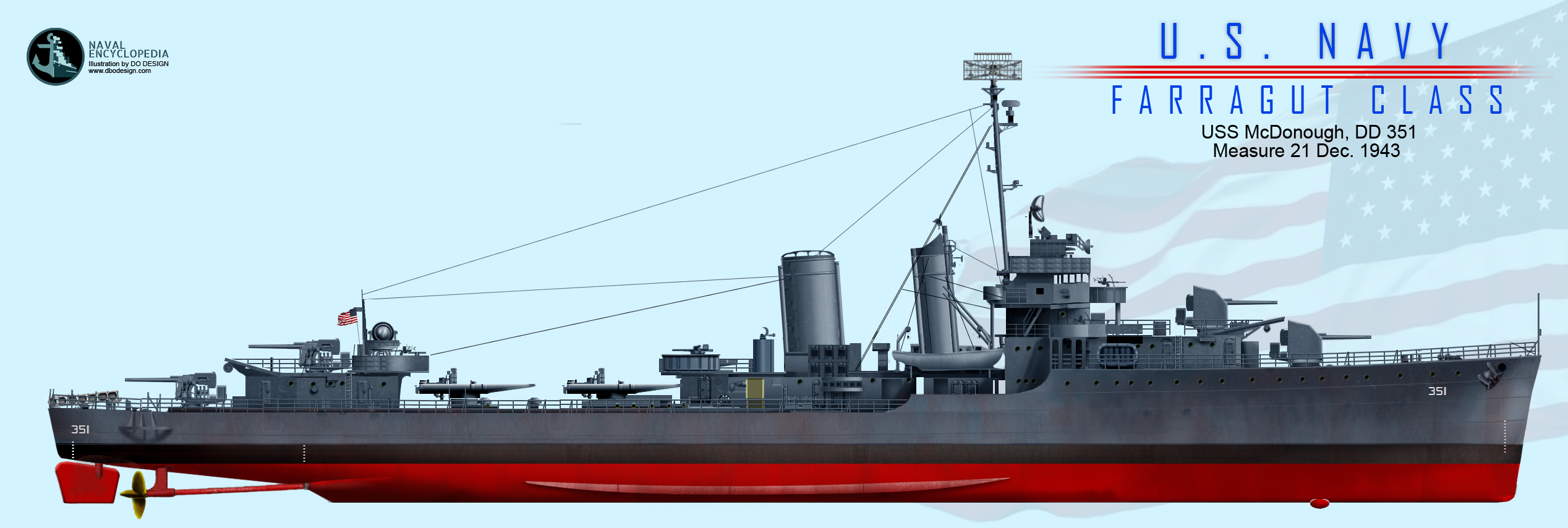
USS Mc Donough in December 1943, Measure 21 Ocean blue
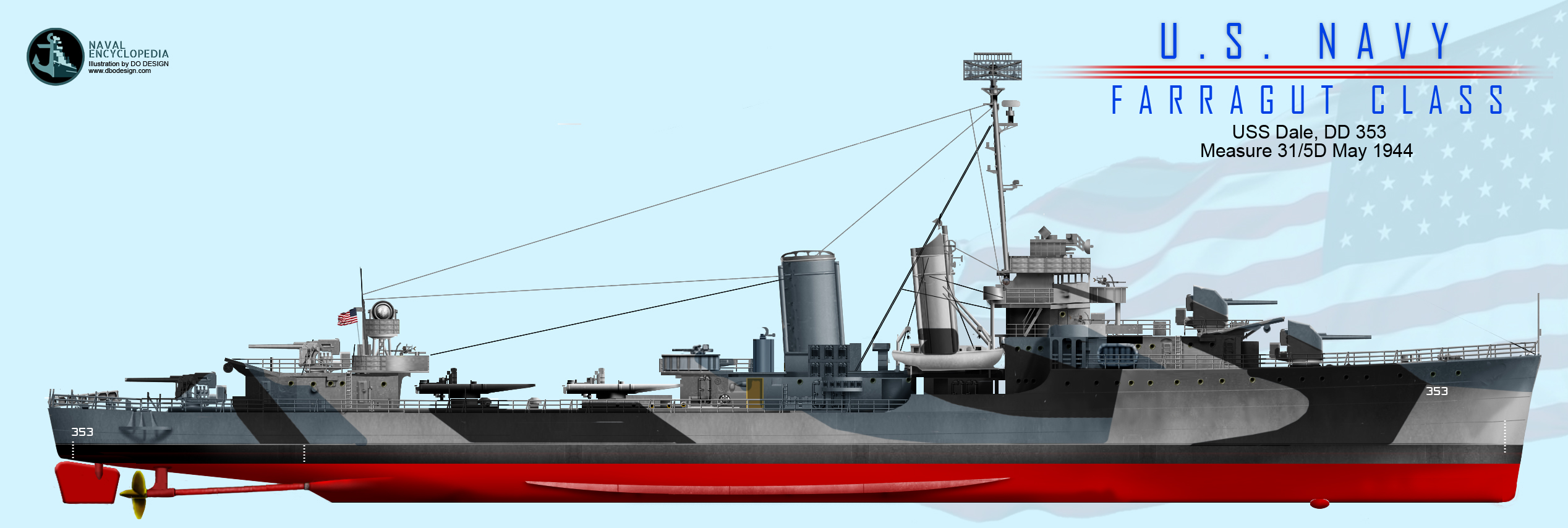
USS Dale in measure 31 design 5D, May 1944
⚙ specifications |
|
| Displacement | 1,365 tons standard, 2,064 tons fully loaded |
| Dimensions | 104.01 x 10.44 x 4.93 m ( 341 ft 3 inx34 ft 3 in x 16 ft 2 in) |
| Propulsion | 2 shafts Parsons turbines, 4 Yarrow boilers, 42,800 shp (31,900 kW) |
| Speed | 37 knots (69 km/h; 43 mph) |
| Range | 5,980 nautical miles (11,070 km; 6,880 mi) at 12 kn (22 km/h; 14 mph) |
| Armament | 5x 5-in/38 DP, 4x 0.5-in Browning AA, 2×4 21-in TTs, see notes |
| Sensors | Mk33 GFCS, SC radar, sonar (1943) |
| Crew | 160 peacetime, 250 wartime |
Read More
Books
Clavin, Tom & Bob Drury. Halsey’s Typhoon: The True Story of a Fighting Admiral, an Epic Storm, and an Untold Rescue; Grove Press
Capsizing of USS Hull in typhoon off Luzon : Narrative by Lt. Commdr. Jame A. Marks, 18 December 1944
“Typhoon Cobra” by Carl M. Berntsen, SoM1/C, USS De Haven (DD-727) Sailors Association website
“Tide to History” by Greil Marcus, The Threepenny Review, Spring 2008
Typhoon Cobra, USS Hull (DD-350) & USS Hull (DD-945) association
Melton Jr., Buckner F. Sea Cobra, Admiral Halsey’s Task Force and the Great Pacific Typhoon Lyons Press
Greil Marcus: a life in writing by Simon Reynolds, The Guardian, 18 February 2012
Links
https://www.history.navy.mil/our-collections/photography/us-navy-ships/alphabetical-listing/f/uss-farragut–dd-348-0.html
http://www.historyofwar.org/articles/weapons_farragut_class_destroyers.html
http://pwencycl.kgbudge.com/F/a/Farragut_class.htm
http://www.navweaps.com/Weapons/WNUS_5-38_mk12.php
http://www.navweaps.com/Weapons/WAMUS_ASW.php
http://www.navweaps.com/Weapons/WNUS_Radar_WWII.php
https://destroyerhistory.org/destroyers/introduction/
https://zlibrary.to/pdfs/aboard-the-farragut-class-destroyers-in-world-war-ii-a-history-with-first-person-accounts-of-enlisted-men-pdf
https://naval-encyclopedia.com/docs/Aboard_the_Farragut_Class_Destroyers_First-PersonAccounts.pdf
https://en.wikipedia.org/wiki/Farragut-class_destroyer_(1934)
https://commons.wikimedia.org/wiki/Category:Farragut_class_destroyers_(1934)
Model Kits
First off, we have a 1:96 kit signed by The Scale Shipyard, and retooled in 1999. The “hottest” to these days are the Iron Shipwrights and Black Cat Models 1:350 (as well as the Commander Series Models kit), still maintained to this day. For this who want it compact, there is the Niko Model 1:700.
General query on scalemates.
More on the USS Hull 1:350 by Iron Shipwrights
The Farragut class destroyers in service
 USS Farragut (ex-Smith, DD348)
USS Farragut (ex-Smith, DD348)
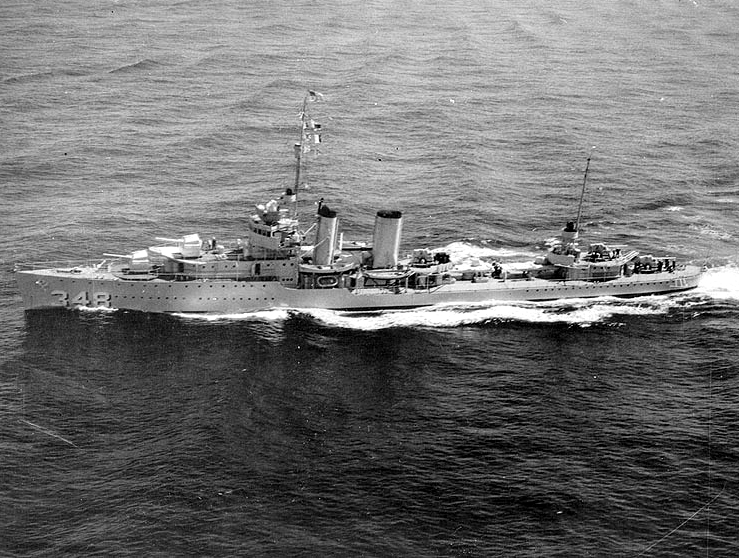
Built in Bethlehem, Quincy, laid down in Sept. 1932, launched 15.3.1934, HMS Farragut was commissioned in June 1934, 18th, commanded by Elliott Buckmaster. Her early service was spent into developmental operations, to test the klimits of a brand new, experimental design in the USN. These were vital operations, although already not results could be taken in account for the following Mahan class. She made a first long shakedown cruise from her first homeport, Norfolk in Virginia to the Caribbean and trained further along the east coast. On 26 March 1935 she hosted President Franklin D. Roosevelt at Jacksonville in Florida to meet at sea his private yacht. The president was a former secretary of the Navy ans always had been close to naval questions so he was quite interseted by this brand new design, so important for the future. Then, DD 348 turned into an escort while the Presidential yacht reached the Bahamas. On 7 April the President board her again for the return trip to Jacksonville concluded on 8 April.
USS Farragut was then reassigned to the Pacific fleet, assigned to her new home port, San Diego in California, transiting by Panama and arriving on 19 April 1935 with DesRon 20, naturally as flagship. The rest of the squadron was indeed composed of Clemson class vessels. She joined the annual west coast fleet maneuvers and pushed to Hawaiian waters, and due noth in the summer, training the Naval Reserve off Alaska, a routine that went on until 3 January 1939. After Carribean fleet maneuvers and an overhaul in San Diego the new international context meant on 2 October she was mived permanently to Pearl Harbor, screen fleets carriers going there. From 1 August 1941, she was still in exercises with the carrier task forces.
The “day of infamy” she was berthed in in East Loch with other destroyers. Onboard that day was Ensign James Armen Benham (engineering officer, senior) and managed with little crew available to fire her engines and had her moved down the channel while firing all along. The “improvized skipper” was later awarded the Bronze Star. Until March 1942 she stayed in Hawaiian waters and patrolled from there to San Francisco, escorting convoys.
On 15 April she was assigned to the USS Lexington (CV-2) task force and sent to the Coral Sea, later joining USS Yorktown (CV-5). She therefore took part in the Battle of the Coral Sea in May. From 6 May she was part of a unified TF 17 trying to make contact with the IJN “Mo” operation force (on Port Moresby) and detached in the searching Support Group. Attacked by aviation she contributed to the five aircraft shot down that day, unscaved.
She arrived in Cid Harbor, Australia on the 11th to resplenish and wait furher orders, before proceeding back to Pearl on 29 June after visiting Brisbane, Nouméa, Suva, Tongatapu, and Auckland while escorting a convoy. She sortied again on 7 July with the USS Saratoga (CV-3) task force for the Solomon Islands. She screened her during the assault on Guadalcanal on 7 August, and was detached to protect sea lanes. She was involved on the 25 in the air Battle over the Eastern Solomons.
After guarding convoys to Guadalana, she also escorted convoys from Australia to Espiritu Santo, Nouméa in new Caledonia Fiji before reaching back Pearl Harbor on 27 January 1943, for an new overhaul, AA and radar additions, and further training.
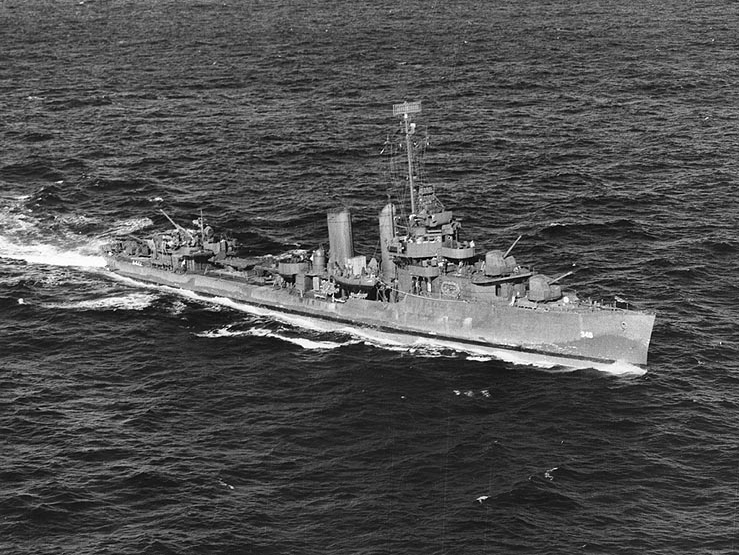
Next she was assigned to the Aleutian campaign task force, departing to Adak in April, patrolled Alaskan waters until 11 May and protecting troopship landing on Adak. She repelled an enemy submarine and went on in her patrols until June, then swapping on Kiska, also bombarding IJN objectives on the island and protecting the landings on 15 August. She left in September 1943 for San Francisco, after an intense eight month campaign.
Leaving San Diego on 19 October 1943, she stopped at Pearl and arrived in Espiritu Santo to cover the landings on Tarawa 20 November, returning to Pearl on 8 December. On 13 January 1944 she took part in the Marshall Islands Campaig, covering the carriers against submarines during the landings on Kwajalein and Eniwetok. She went on during the air strikes on Woleai and Wakde. By April 1944, patrolled off New Guinea during the landings at Hollandia and in May, Majuro.
She screened TF 58 off Saipan from 11 June 1944 and the landings, bombarding various objectives on demand at Saipan and Guam and placed as a radar picket during the Battle of the Philippine Sea 19-20 June, resplenishing at Eniwetok until 14 July. Next she was present off Guam for cover fire notably closer to the shore for the underwater demolition teams before the main assault. She was back to Guam on 21 July between patrols and sorties with the covering Fire Support Group. On 25 July this was off Rota, but she needed a solid overhaul and departed for Puget Sound Navy Yard.
Back from the drydock she proceeded to Ulithi, arriving on 21 November 1944, and escorting oilers of the support force for the carrier task force moving against Taiwan and Luzon. She was based in Ulithi and followed the assault on Iwo Jima and Okinawa, on carrier screen duties with her reinforced AA on 25-28 April 1945 and during the Ryukyus strikes. Until 6 August 1945, she escorted convoys between Ulithi and Okinawa, bu also served briefly as radar picket off Okinawa.
Her last mission was off Saipan when the war ended on 5 August. On the 21th she departed for the Brooklyn Navy Yard to be decommissioned on 23 October but only stricken on 28 January 1947, sold on 14 August 1947 for scrap. For her wartime service she earned 14 battle stars, this was far more than most Sumner and Gearing vessels just entering service.
 USS Dewey (ex-Phelps) (DD349)
USS Dewey (ex-Phelps) (DD349)

USS Dewey, ex-Phelps, ex-Dewey was started at basin 154 in Bath Iron Works by December 1932, launched 28.7.1934 and commissioned in October 1934 with Commander H. W. Hill in command.
She made two training cruises off Cuba including her shakedown cruise, stopping at Port-au-Prince in Haiti and returned to home port Norfolk. By April 1935 she was assigned to the Pacific fleet, sailing to San Diego (14 April), and like her sister Farragut until 1938 was part of carrier screens and local operations, fleet problems and battle practice, also cruising from Alaska to Peru, also making three stays in Pearl Harbor. From 4 January 1939 she took part in the Fleet Problem of the Atlantic Squadron but was soon back in Pearl Harbor on 12 October 1939 taking part in the fleet problems of that year and 1940.
She was making a tender overhaul when the attack on Pearl Harbor commenced, opening fire and in the afternoon, with her full crew aboard, sailed to patrol the Hawaiian waters, hoping to catch any IJN submarine or vessel. On 15 December she was assigned to TF 11 (USS Lexington) sent to relieve Wake Island, operation soon cancelled. In February 1942 still with TF 11 she sailed for planned raid on Rabaul, also canceled, but Dewey helped repelled an air attack of 18 bombers. She followed “lady lex” during the raids on Lae and Salamaua (New Guinea) on 10 March.
On 15 April 1942 she was part of the expedition to the Solomon Islands and on 5 May as the attack on Port Moresby was ongoing, her group was joined to that of USS Yorktown so she could take part in the battle of the Coral Sea. She tried to protect Lexington the best she could but had herself five crewmen wounded by strafing. USS Dewey later took part in the rescue of the cripplied carrier, saving 112. She joined Yorktown’s screen to Nouméa on 12 May and was back to Pearl Harbor on 25 May, this time with USS Enterprise.
Now assigned permanently to USS Enterprise task force she took part in the Battle of Midway on 6 June, back in pearl on the 9th. She was assigned to “Lady Sara”, USS Saratoga, bringing an air squadron to Midway on 22-29 June. By 7 she covered the initial landings on Guadalcanal and returned there for direct support shelling on 7 August. Attacked by Aichi D3A2 “Val” dive bombers, have a crewman wounded. She also helped the crippled USS Jarvis and towed USS George F. Elliott although she was later abandoned, and she took aboard 40 survivors.
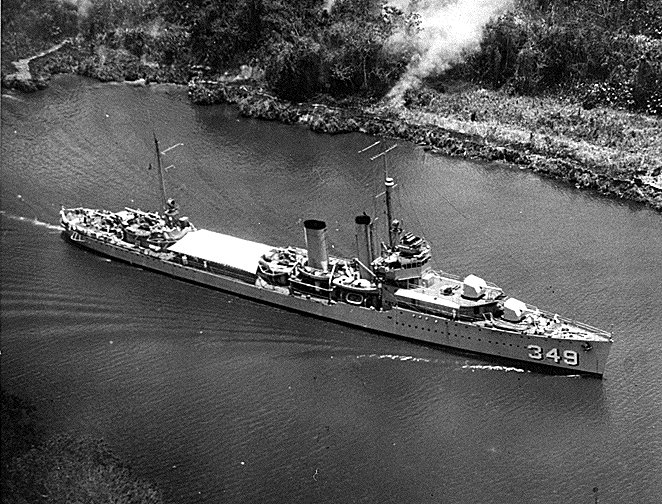
USS Dewey stayed in the Solomons, escorting supply convoys, screening Saratoga at the battle of the Eastern Solomons on 24 August 1942. She escorted her after she took a torpedo hit on 31 August to Pearl Harbor, herself sent home at San Francisco, Puget Sound, for an overhaul. She was back on 27 December 1942 this time for the Alaskan operations, with her sister Farragut. She tried to pull out (but failed) USS Worden at Amchitka, and later rescued survivors. On 7 April 1943, she sailed for San Pedro and came back for the invasion of Attu on 11 May, followed by Kiska on 15 August, then taking back a group of LSTs to San Francisco (19 September). She spent there the remainder of the year, with a crew’s well deserved leave.
After stopping at San Diego she departed on 13 January 1944 for the new operating base of Kwajalein on 31 January, always as an escort, for the raid on Majuro (11 February) invasion of Eniwetok (18 February) and patrolling between there and Roi to Majuro. She also shelled Mille Atoll on 17–18 March and until 6 June screened TF 58 during the raids on Palau, Yap, Ulithi and Woleai, invasion of Hollandia, the strike on Truk, and then the operations against Tinian and Saipan (11 June), called for shelling on Saipan and Tinian (13-14 June) destroying enemy barges and setting alight an oil dump. She took part in the Marianas landings, and took part in the battle of the Philippine Sea in June, rescuing downed pilots.
She covered transports on 1 July 1944 on their way to land on Guam and assoted this with close fire support for the underwater demolition teams, plus night harassing fire and patrols, until 28 July, followed by an overhaul at Puget Sound. She was back on 30 September 1944 integrating the screen for the logistics group, 3rd Fleet, on 10 October, present during TF 58 refueling operations for the Philippines invasion. However she was hit by the Typhoon on 18 December. Completely battered she eventually lost all power by noon, and powerless, she turned into the wave roll going down to 75° prompting the captain to prepare evacuation. She had a stack torn but no casualties. On 8 February 1945 she was repaired in Ulithi and sailed for Iwo Jima (17 February) assisting the burning USS Patuxent and caled for precision gunnery for the Marines, starting on 19 February. Her main guns repelled a fierce night Japanese counter-attack on the 23th.
She escorted a convoy to Leyte (4-6 March 1945) before returning to the logistics group deployed in support for the Landings on Okinawa (operation Iceberg), screening precious oilers refuelling the fast carrier task force preparing their initial air strikes. This went on with the Kuyshu raids until 15 August. At that time, she had won 13 battle stars. On 21 August, she headed for San Diego and by September she continue on the east coast to Brooklyn Navy Yard (25th) to be inactivated, then decommissioned on 19 October, but sold on 20 December 1946.
 HMS Hull (DD350)
HMS Hull (DD350)
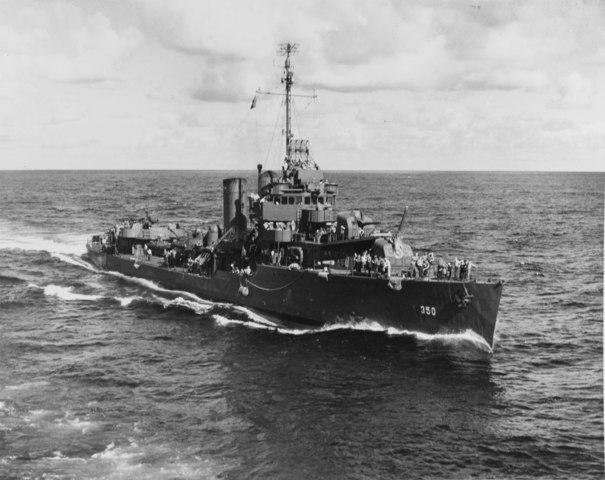
USS Hull underway in her navy blue livery (measure MS-33a), May 1944.
USS Hull was started in New York Naval Yard, Brooklyn in March 1933, launched 31.1.1934 and commissioned by January. She made her shakedown cruise in the Azores and Portugal, but also up to Britain before sailing back to San Diego via the Panama Canal, on 19 October 1935. Pacific Fleet tactical exercises, training went on and the next year she cruised to Alaska. In 1937 she made a fleet exercize off Hawaii and close to the carriers, acted as plane guard being moved after the start of WW2 in Pearl Harbor from 12 October 1939.
On 7 December 1941 USS Hull was berthed next to the tender USS Dobbin (AD-3) and under repairs, but the personal present managed to have her anti-aircraft batteries back in action. A low priority target she was unscaved, and able to depart on the 8th to join USS Enterprise (CV-6) as she approached to enter Pearl Harbor. She was assigned TF 11 (Admiral Wilson Brown) to screen USS Lexington (CV-2) en route to the Solomon Islands. For 3 months she escorted convoys between San Francisco and Pearl Harbor.
She was sent in the Fiji Islands to prepare for the landings at Guadalcanal, en route on 26 July and arriving on 7 August 1942, acting as antisubmarine screen along the transport’s columns. Her AA was put to good use when repelleing a bomber attack, and she shared several kills. To avoid the transport George F. Elliott, badly hit, to fall in Japanese hands, she finished her off. On 9 August she spotted and destroyed a presumably Japanese schooner off Guadalcanal and sailed for Espiritu Santo. She undertook three convoy escorts to Guadalcanal, and repelled air attacks on 9 and 14 September.
Back to Pearl Harbor on 20 October she was attached to USS Colorado (BB-45) as part of a new task force sent in the New Hebrides, departing on 29 January from Pearl Harbor to San Francisco, and after overhaul, sailed for the Aleutian Islands, starting with Adak on 16 April, training, and sent to Attu in May 1943 and by July-August provided shore bombardments on Kiska and the landings, unopposed.
Back to Pearl Harbor on 26 September 1943 she was prepared for the Wake Island invasion, escorting the escort carriers leading diversionary strikes whereas Gilbert Islands was targeted. She shelled Makin Is. on 20 November, and was back to Pearl on 7 December 1943, then proceed to a training off Oakland in California by 21 December, follopwed by the new year’s leave. In January she was back in the Marshall Islands with TF 53 from San Diego (13 January 1944). She stopped first in Kwajalein to escort transports and went on in screening and patrol also around Majuro. She took part of the shelling of Mille Atoll on 18 March and Wotje on the 22th.
Next she escorted the carriers launching an air raid on Truk (29–30 April) and was back to Majuro in May reassigned to Admiral Lee’s battleships force committed in the Marianas Islands campaign. Sge shelled Saipan on 13 June and protected minesweepers opening the way into the lagoon. On the 17 she joined Admiral Marc Mitscher’s carrier task force soon hit by four large air raids, Hull providing cover for Task Group 58.2. What followed was the “The Great Marianas Turkey Shoot” on 19 June. Hull’s AA gunners remained in high alert all along.
By July 1944 she operated off Guam and patrolled off the island and the next month was back in Seattle, Washington, for an overhaul until 23 October, returning to Pearl Harbor and missing the Battle of Leyte. Assigned to the 3rd Fleet refueling group in November 1944 she met the fast carrier striking forces in the Philippine Sea under William Halsey Jr. for a great refilling operation, which was badly hit by Typhoon Cobra on 17 December, which was her doom:
Hull was ordered to change course while wind increased the following day, the weather deteriorating so much she was soon unable to steer with the north wind on her port beam, rolling almost beyond recovery and everything on deck washed over. A gust stuck her into the water while at 70% list, and seawater poured in the pilot house and smokestacks. Her crew managed to avoid the worst but despite all their efforts, USS Hull remained stuck on her flank, at 80%. Captain Lt. Cmdr James A. Marks could only give loose instructions at that point, seeing his ship unrecoverable. He nearly escaped mutiny due to opposition by the executive officer (XO) Greil Gerstley (This inspired the novel “The Caine Mutiny” also taking place during Typhoon Cobra).
USS Tabberer and other ships managed to rescue in the storm, in appealing conditions, 7 officers plus the captain and 55 sailors but the ship sank with 11 officers and 191 sailors nevertheless. This loss, with USS Monaghan, led to a commission of enquiry and Halsey was replaced, saved from a sanction by the reports of several officers led by Nimitz claiming the individual responsibility of many captains not to have provided adequate measures to prevent the worst. Admiral Spruance, which took command in turn, nevertheless was also blamed when hit by typhoon Connie, still tremendous damage but no ship loss.
 USS MacDonough (DD351)
USS MacDonough (DD351)

USS MacDonough during the Aleutian campaign in mid-1943. Note the red band on the bridge’s center.
USS McDonough was started in Boston N Yd in Charlestown by May 1933, launched 22.8.1934 and commissioned on 15 March 1935 with Commander Charles S. Alden at the helm.
After a long shakedown cruise to Europe as her sister Hull, she also visited ports in western South America before proceeding via Panama to the Pacific Fleet, San Diego, entering into a routine of yearly training and long cruises from Alaska to Peru. By October 1939 like the other destroyers in her class she was reassigned to Pearl Harbor in Destroyer Squadron 1 (DesRon 1). On 7 December her crew rushed onboard to man the gun and she managed to shoot one Japanese aicraft. Later that day she join the effort to locate the Japanese fleet. The next three months and a half, she patrolled southwest of Oahu and started to escort convoys from the US west coast to Pearl, but she was detached to be deployed for the campaign of New Guinea, covering the Bougainville, Salamaua, and Lae air raids.
She also later took part in the Guadalcanal invasion as part of USS Saratoga screen. She remained in the area in August and ws present during the Battle of Savo Island and went on escorting supply convoys and reinforcements to Guadalcanal, and by late September escorted convoys between New Guinea, Espiritu Santo and Pearl Harbor. By late December she was sent to Mare Island Arsenal for her first major overhaul, ans stayed there until February 1943 and crew’s new year’s rest.
USS Macdonough, like many of her class’s ships took part in the northern Pacific campaign or The Aleutians Campaign. She indeed took part in the Attu Island attack, and patrolled from Adak until the landings on Attu. On 10 May however, in heavy weather she collided with one of the transport under her care, SS Sicard. Badly damaged, she was towed to Mare Island, repaired until 23 September. Next she sailed out ot join the Gilbert Islands Campaign. She covered the invasion of Makin Island on 20 November, being assigned as control ship to supervize landing craft areas and rotations. She entered the lagoon and provided close gunnery support during the Marines progression. On 23 November she returned to Pearl Harbor.
Next, USS Macdonough was assigned to join the Marshall Islands task force by January 1944, Northern Attack Force. She became the main fighter director ship off Kwajalein Atoll. On 29 January she moved to Wotje Atoll, providing shore bombardment and moved to Kwajalein. Next she carried out the support for the occupation of Roi-Namur, acting afterwards as radar picket before proceeding back to Eniwetok. On 21-22 February 1944 she shelled Japanese positions on Parry Island, at the entrance to the large Eniwetok lagoon.
By March 1944, she became the center ship for the whole TF 58 RDV point before proceeding to attack the Palau Islands. Next she was found fighting off Hollandia in New Guinea, shelling positions on 21 April. Next she acted as radar picket south of Truk in May, spotting and guiding USS Monterey (CVL-26) and USS Stephen Potter (DD-538) which chased and sunk the IJN submarien Ro-45, on 30 April 1944.
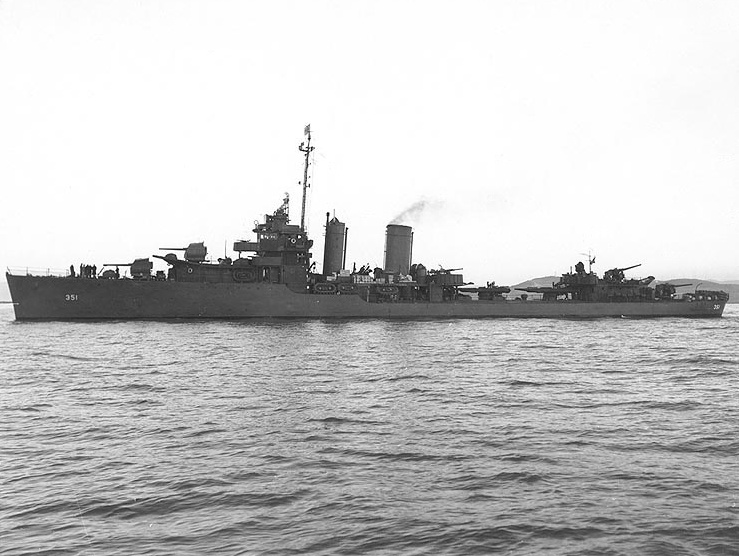
On 4 May she was sent to Majuro gathering point wating for the Marianas Invasion. From the Marshalls on 6 June she screened the fast carrier force on her first step, the assault on Saipan, screening, picket posting, and shore bombardment (west side). She was present at the Battle of the Philippine Sea and shared kills with othjer ships that day.Next she close covered underwater demolition teams opering on the beaches of Guam before the assault (other Farragut class ships with her). By 21 July she patrolled around Guam for submarines, and steamed to Pearl Harbor on 10 August.
After returning to the Admiralty Islands, Manus (15 September) in escort, she was present off Leyte on 14 October screening the troop transports, participating from afar to the Battle of Leyte Gulf. Back to Manus she escorted anither convoy on 3 November and patrolled Leyte Gulf and the Surigao Strait. By December, she escorted yet another convoy off Ulithi, and was given the care of several fleet oilers vital for at-sea refuelling operation of the fast carrier force. In January 1945, she returned for a 3 month overhaul at Puget Sound before proceeding back to Ulithi and acting as a radar picket there on 5 July, before returning to convoys escort until 15 August, between Ulithi and Okinawa.
She was in Guam when notified to get back home, San Diego (3 September) and New York Navy Yard for inactivation and decommission on 22 October, then to be sold on 20 December 1946, to George H. Nutman of Brooklyn for scrapping. Her battle record counted at the time 13 battle stars, cherished up to this day on a board where veterans met in the postwar years.
 USS Worden (DD352)
USS Worden (DD352)
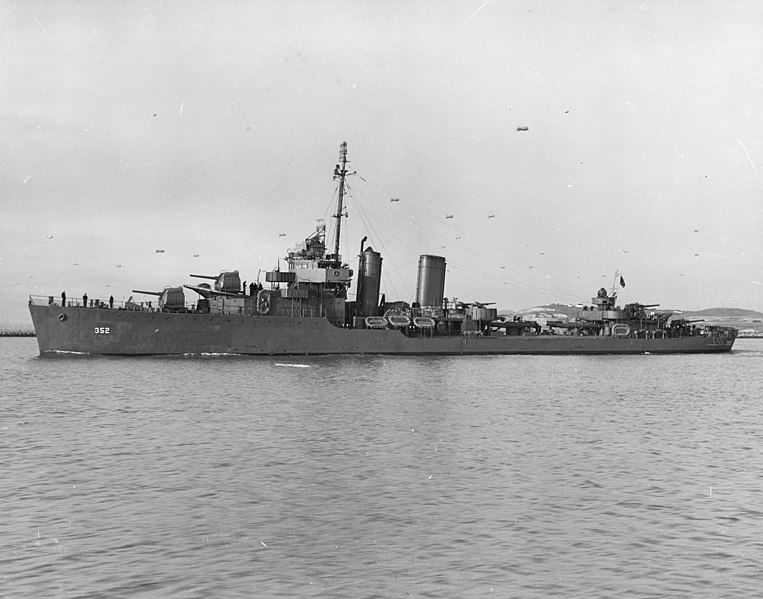
USS Worden leaving Mare Island Arsenal on 21 November 1942, in navy blue livery. Note the Bofors and Oerlikon AA mounts are well visible.
USS Worden was built at Puget Sound Naval Yard in Bremerton, started in December 1932 and launched on 27.10.1934, commissioned in January 1935. She departed Puget Sound on 1 April 1935 for her shakedown cruise via San Diego, and south, via Mexico, Guatemala, and Puntarenas in Costa Rica before corssing the Panama Canal on 6 May for Washington, D.C.. There, she embarked Rear Admiral Joseph K. Taussig the Assistant CNO and congressional party on the Potomac River, down to Mount Vernon. Later in Washington Nyd she had her guns were disassembled for alterations and sailed for Norfolk NyD for fixes, and trials off Rockland (Maine). She started training off New Bedford in Massachusetts and sailed to Guantanamo, Panama Canal, and to Puget Sound on 3 August 1935.
Her post-shakedown refit done she called San Diego as new home port for 4 years of intensive training, cruises and fleet problems. She also performed training for the Fleet Sound School based in San Diego while cruising from Alaska, to Peru. She made three stays in Hawaiian waters and by the autumn of 1937 with her sister Hull (DD-350) she screened USS Ranger (CV-4) to Callao in Peru at the same time as the Inter-American Technical Aviation Conference at Lima.
From 1 September 1939 USS Worden she started Neutrality Patrol and on the 22th September the CNO, admiral Harold Rainsford Stark (Admiral King was only appointed on 18 March 1942), directed the CiC to transfer temporarily, two heavy cruiser divisions and their attached destroyer flotilla flagship light cruiser plus two destroyer squadrons as the “Hawaiian Detachment” under Vice Admiral Adolphus Andrews (flagship Indianapolis, CA-35), first step before the Fleet was entirely moved at Pearl Harbor. Until the attack USS Woredn performed fleet exercises cut by short upkeep periods on the west coast. Fleet Problem XXI was her last, in the Spring of 1940 seeing the whole Fleet based in Pearl Harbor.
7 December 1941 saw her berthed alongside the destroyer tender Dobbin (AD-3) in upkeep and being a secondary objective she was left unscaved, but not inactive. Gunner Quartermaster 3d Class Raymond H. Brubaker shot down indeed one “Val” with a Browning fifty cal. and after two houre like other destroyers she was open sea looking for the Japanese. She eventually picked up a submarine contact at 12:40 and dropped seven depth charges before joining the task force led by USS Detroit (CL-8), flagship, RADM Milo Draemel. After scanning southwest of Oahu and refualling at the USS Neosho (AO-23) she met Admiral Aubrey W. Fitch’s TF 11 built (USS Lexington).
After a new refuelling on the 11th she left the TF to escort Neosho to Pearl when USS Dewey (DD-349) spotted a submersible and attacked. Worden was back on 14 December to sail for Wake Island when recalled on 22 December. Patrol and escorts went on locally, and she attacked to suspected enemy submarine off Oahu on 16-18 January 1942. She escorted the seaplane tender Curtiss (AV-4), fleet oiler Platte (AO-24) via Samoa and Fiji to Nouméa, New Caledonia, the new south Pacific operating base for the USN, poiseed to retake the Solomons as a first step. She assisted in late February the merchantman SS Snark, after hitting a mine in Bulari Passage near Nouméa. On 7 March with USS Curtiss she headed for Pearl Harbor and was reassigned to TF 11 on 14 April.
With USS Lexington she was off New Hebrides on 1 May to joined RADM Fletcher’s TF 17 (USS Yorktown, CV-5). She was detached to escort fleet oiler USS Tippecanoe (AO-21) to Nouméa, missing the Battle of the Coral Sea.
USS Worden on the 14th met TF 16 (Halsey, USS Enterprise and Hornet) off Efate, New Hebrides, in time for the Battle of Midway. She left Pearl on the 22th with TF 16 (this time udner RADM Spruance) meeting TF 17 (USS Yorktown) north of Midway Island, “ambush position”. USS Worden screened Enterprise and Hornet on 4-6 June 1942, her AA fired at one occasion but made no kill. Back to Pearl Harbor she was assigned to TF 11 (USS Saratoga) flying reinforcement groups and spent the rest training. On 9 July she sailed for South Pacific but was detached to escort USS Platte to Nouméa and later both were back to USS Saratoga, stopping during a night to pickup 36 survivors of the sunken Army transport Tjinegara torpedoed by I-169 75 miles SW of Nouméa. South of Fiji Islands she escorted the invasion fleet for the Solomon campaign, but she was detached again to escort the fleet oiler Cimarron (AO-22) to Nouméa.
Back with TF 16 on 3 August she screened Saratoga during the Guadalcanal-Tulagi strikes. Soon however she would take part in the Battle of the Eastern Solomons.
Still with Saratoga south of the Solomons, she escorted convoys to Guadalcanal and during the Battle, screened Saratoga and Enterprise which air strikes claimed Ryūjō and damaged Chitose. A week later I-26 torpedoed Saratoga and she escorted her to repairs via Tongatapu (Tonga) and Pearl Harbor, and then San Francisco on 4 October. USS Woredn soon departed to escort USS Gansevoort (DD-608) and USS Idaho to Puget Sound and she was back in San Francisco to join USS Dewey escorting USS Nevada in post-repair trials.
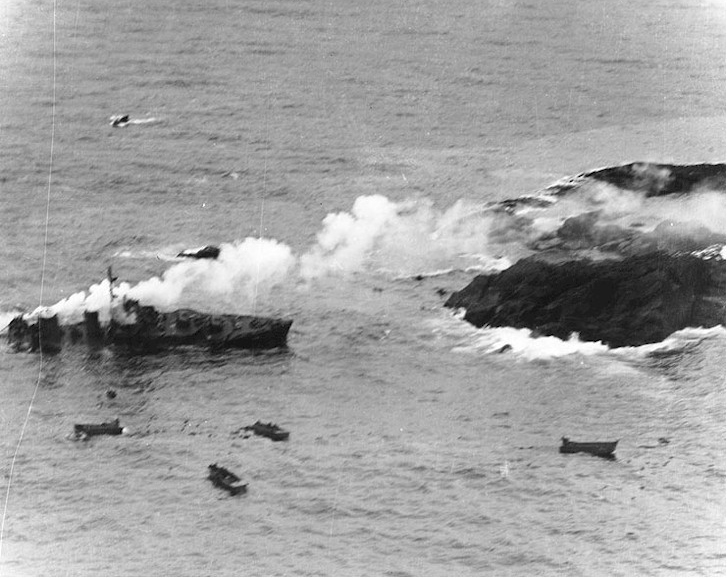
The loss of USS Worden in Constantine Harbor, Amchitka Island
On 27 December 1942, she like her sister, took part in the Aleutian campaign, escorting the convoy for the occupation of Amchitka Island. After stopping at Dutch Harbor in Alaska, on 12 January, she escorted USS Middleton (AP-55) on the shores of Constantine Harbor in Amchitka, but while maneuvering into the difficult, rock-jagged harbor, a strong current swept her onto a pinnacle penetrating her hull beneath the engine room. She was flooded and lost all power. USS Dewey tried to tow her out free, but the cable snapped while heavy seas tossed Worden further on the rocky shore until she broke up, CO, CDR William G. Pogue ordered to abandon ship. But he was swept overboard and later fortunately rescued while unconscious. 14 sailors drowned and the ship was struck from the list on 22 December 1944, with 4 battle stars for her credit.
 USS Dale (DD353)
USS Dale (DD353)

Started at New York NYd in Brooklyn by February 1934, launched 23.1.1935, USS Dale was completed in June 1935. USS Dale made her southern shakedown cruise (13 February – 6 March 1936 via Galveston in Texas and escorting President F. D. Roosevelt’s cruise in the Bahamas. Based in San Diego, she took part in yearly fleet problems and cruised from Alaska to Callao in Peru, and training gunners for San Diego’s school. On 5 October 1939, she was assigned to the Hawaiian Detachment.
The day of the attack on Pearl Harbor she was moored with DesDiv 2, Berth X-14, sandwiched after USS Aylwin, USS Farragut, herself, and USS Monaghan. Ensign F.M. Radel was onboard that day, spotting the Japanese’s first attack on USS Utah and signalled General Quarters. He ordered to light all boilers and man all guns. At 08:10 the .50-caliber started backing and soon the five-inch guns, with the ready rooms, fortunately not at shore under lockers. The gunners in their position could do little however and at 08:15 she shot down a “Val” attacking USS Raleigh.
At 08:20 she ready to get underway and when clearing her anchorage, saw a torpedo passing under her bow, exploding on Ford Island. At 08:44 she was close to USS Monaghan dropping depth charges on a midget sub closing on USS Curtiss. At 25 knots she left the harbor with Monaghan behind, and was soon framed by dive bombers, strafed, while near the entrance. She had close misses but no damage.
Later another attack saw her gunners claiming the leading plane, the remainder two being driven off. She had to make frequent course changes and high speed bursts to foil air attacks, making her sonar useless to track down Japanese subs. USS Worden was made Commander of DesRon 1 and Dale was the third ship in column, investigating three enemy transports signalled off Barbers Point (bogus report) she screened USS Detroit, USS Phoenix, USS St. Louis, and USS Astoria which sorties to try to catch the Japanese, being assigned station 9 at 25 knots. She however had to turn back, having the pinion bearings on the reduction gear failing, retiring at 10 knots. After repairs she tried to reach the task force, but full repairs were needed and she was assigned offshore patrol in sector 1 until joining TF 8.4.
From 14 December 1941 to 17 March 1942, she screened Lexington and Yorktown during the Salamaua–Lae raids (New Guinea) and by 11 Mays was sent to Mare Island for her first wartime overhaul. She left in June San Francisco for a back up of the forces comitted in the Battle of Midway, assigned convoy escort missioned between Viti Levu, Fiji, Efate, Espiritu Santo, and prepared for the Guadalcanal campaign. In August she covered the landings and escort reinforcements. She was back in Pearl Harbor until 10 November and next was attached to USS Washington and USS South Dakota, then the latter alone going back to San Francisco. There, she was prepared for the Aleutian campaign operations.
On 9 January 1943, she left San Francisco for Aleutian waters, supporting the landings of Amchitka until 19 March, and on the 22th patrolled west of Attu, preying on enemy shipping. They were soon involved to fight off a superior force at the Battle of the Komandorski Islands. USS Dale soon duelled with the Japanese cruisers, screening the damaged USS Salt Lake City to safety. Later she screened transports into Attu and covered the attack on 11 May, detached to patrol around the island on 1 August. She took part in the preinvasion bombardment of Kiska the following day, screened more transports for the 13 August landing, joining USS Kane and taking part in the Rat and Buldir Islands attack on 22 August. She left Adak on 5 September 1943 for Pearl Harbor, screening a returnbing oilers convoy and training off Pearl Harbor until 5 November, then escorted LSTs en rout for Makin on 20 November.

She was back to San Diego on 13 January 1944 for upkeep and returned with new Essex class carriers assigned the assaults on Kwajalein and Eniwetok. She was in the Marshalls until 22 March and attached to TF 58 for the raids on Palau, Yap, Ulithi and Woleai until 1st April and Hollandia operations (21-24 April), strikes on Truk, Satawan and Ponape until 1st May. On 6 June-30 July she was in the Marianas, making direct shellings of Saipan and Guam and screening carriers, taking part in the Battle of the Philippine Sea.
Like her sisters she covered underwater demolition teams by night. Her second overhaul was done at Bremerton NyD in August-October 1944 and she joined Pearl Harbor and Ulithi with TF 38, missing the battle of Leyte but assisting the Philippines invasion (25 November-8 December) and then screen TF 58 durng the Chinese coast raids (Formosa, Luzon, Okinawa), then the first carrier strikes on Kyushu island. She escorted the logistics group at five occasions (between Ulithi and Okinawa). On 11 June she headed for Leyte and escorted another convoy to Ulithi, patrolling until 29 July and back to Okinawa. On 15 August she was escorting a convoy off Japan. Afterwards she sailed home to San Diego (7 September) and transited to the east coast, New York on 25 September, decommissioned on 16 October 1945, sold on 20 December 1946 with 14 battle stars to her credit.
 USS Monaghan (DD354)
USS Monaghan (DD354)
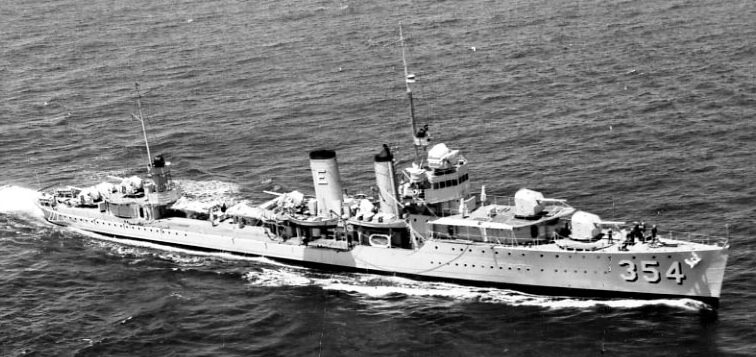
Built at Boston N Yd from Novemner 1933 and launched on 9.1.1935, USS Monaghan was completed in April 1935. Her early career 1935-39 was the same as other destoryers of her class. She served in the Pacific, San Diego, alternativing between training cruises from Alaska to Peru and yearly fleet problems. In October 1939 she was attached to Pearl Harbor permanently, her new home port, taking part in the last fleet problem in 1940.
On December 7, 1941, she was a “ready duty” destroyer this sunday, ans to 07:51 was ordered to join the other sentry at sea that day, USS Ward, just sinking an unidentified submarine off the entrance, hourse before the attack itself. While she was underway the air attack started and her AA crew was firing furiously. At 08:27 she was underway to spot a signalled midget submarine in the harbor. Captain LCdr. Burford order to ram the submarine when spotted, the latter turning and firing its torpedo at USS Monaghan, but they missed from 50 yards on her starboard. Monaghan did not missed and rammed the midget, and dropped two depth charges for good effect. However the shallow waters bounced the explosion back to her stern, lifted out of the water. Out of control, Monaghan percuted a barge, but had little damage.
The next week after patrolling offshore, she joined USS Lexington for the later cancelled Wake Island operation. With USS Dale and Aylwin she also attacked an enemy submarine, which was reported sunk. After patrols off Pearl Harbor she sailed with USS Lexington and later detached to escort a convoy to the west coast and back; Then she was reassigned to TF 11 (Lexington) and sortied for the south Pacific on April 15, 1942.
On 4 May she was part of the screen later implied in the Battle of the Coral Sea, with Yorktown and Lexington starting launching air strikes on Tulagi and Gavutu. A pyrrhic victory was secured on 8 May, the 7, sinking Shōhō and repelling a convoy, and on the 8th, USS Monaghan detached to transmit important messages and preserving radio silence for the main formation. Later she tried to locate survivors of USS Neosho and Sims. She was back to TF 16 and back to Pearl Harbor on 26 May.
Next, she was en route with TF 11 at the Battle of Midway. She was in the screen of the combined Hornet, Yorktown and Enterprise force north of the island as they manage to sink the four main enemy fleet carriers of the Kido Butai. Monaghan screened USS Enterprise and detached on 5 June to rescue downed pilots, which were many. At 18:30 she assisted the badly damaged USS Yorktown, guard her from possible air attack, but it’s Japanese submarine I-168 which manage to evade the screen and launche a full broadside that claimed Yorktown and Hammann, Monaghan, Gwin, and Hughes however dealt a sever blow to the submarine but failed to sink her. She escaped.
After Midway she was back in Pearl Harbor on 13 June and sailed for the Aleutians Operations. While en route in foul weather, foggy night, she collided with a transport and received temporary repairs at Dutch Harbor, enough to return to Pearl Harbor. She escorted a convoy to the west coast and entered Mare Island at Vallejo for full repairs, and escorted ships back to Fiji when done on 17 November. She sailed for Nouméa and there, hit an unidentified underwater obstruction, bending her propellers, and had to steam back to Pearl Harbor to have her port screw replaced, being out of drydock on 21 February 1943.
This time she returned to the Aleutians, reassigned to TG 16.69, escorting the cruisers USS Richmond and Salt Lake City on the 26 March at the Battle of the Komandorski Islands. Between heavy artillery fire and agressive torpedo runs, the outnumbered force managed to repel the Japanese. USS Monaghan spent the est of the month in Patrols and shore bombardment, aletrnated with escorts until the end of the summer. She chased a Japanese submarine I-7 avacuating troops fromp kiska, which ultimately was driven on rocks and abandoned.
She made another escort from Pearl Harbor to San Francisco and then San Pedro, to escort three new escort carriers to the Gilbert Islands, via Espiritu Santo (13 November) taking part in the pre-invasion air strikes of Tarawa.
Back to the west coast in escort she was back to the escort carriers off San Diego, bound for the Marshalls, screening them northwest of Roi; On 7 February 1944 she was in Majuro, screening USS Pennsylvania to Kwajalein and assisting the attack on Eniwetok also bombaring Parry Is. on 21/22 February.
On 22 March she was part on an antisubmarine screen for the fast carrier force striking Palau, Woleai, and Yap. On 13 April-4 May, she covered the Hollandia landings and made a strike at Satawan, Truk, and Ponape. Next she took part in the invasion of Saipan in June. She screened TF 58 at the Battle of the Philippine Sea, and patrolled off Saipan. After the usual resupply run at Eniwetok she took part in the invasion of Guam in July, still in the antisubmarine screen. She covered the underwater demolition teams off Agat and provided harassing fire on 18-19 June. On 25 July she was sent to Pearl Harbor and Puget Sound for an overhaul, back to Ulithi in November 1944.
She escorted three fleet oilers meeting on 17 December TF 38, for the pmanned Mindoro invasion. As she planned to refuel she had her ballast reduced to make room for fuel, which only aggravated her natural stability issue. This had fatal consequences when Typhoon Cobra. Of the 790 lives the 3rd Fleet suffered that day, USS Spence, Hull, and Monaghan sank. Only six men survived her sinking rescued by USS Brown. Other sailors signalled she had rolled more and more severely until capsizing to starboard. She was later struck from the register, but earned 12 battle stars.
 USS Aylwin (DD355)
USS Aylwin (DD355)
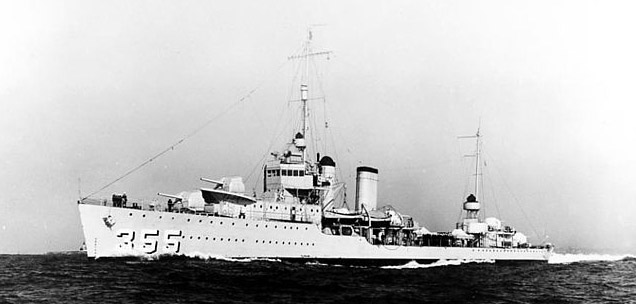
USS Aylwin was built in Philadelphia N Yd, started in September 1933 like USS Farragut but launched on 10.7.1934 and commissioned in March 1935. After inistial yard trials, fitting out, she was sent to the Naval Torpedo Station in Newport to load her torpedoes and make more trials until sent to Philadelphia on 8 May for her shakedown cruise. She toured European countries between Portugal and Spain, France, inspected in Cherbour by ambassador Jesse I. Straus. Next she visited Bremen, Gothenburg, Brussels (Visited there by the Belgian royal family, King Leopold III and Queen Astrid), and finishing with Dover, and back to Philadelphia for post-shakedown fixed.
Next, she departed for the Carribean. She crossed the Panama Canal on 7 October and made a plane guard mission off Guatemala, while testing the flying boat XP3Y-1 (PBY Catalina prototype).
Back with USS Hull she arrived in home port San Diego on 19 October. Peacetime routine with the Fleet was the same as her sisters, and like her in October 1939 she was pressed to join Pearl Harbor as part of the “Hawaiian Detachment”. Her still peacetime service saw the 1940 fleet problems and neutrality patrols in Hawaiian waters, plus West Coast upkeep periods.
On 18-19 March however, USS Aylwin out of Pearl Harbor for off-shore patrol and exercises was making a night tactical exercise, ordered with other destroyers to join the fleet’s center. But at 22:51 while in doubt, she opened her fighting lights sighting a ship arriving fast on her port bow. Maintaining her course and speed she tried soon to to avoid contact but at 23:04, she was percuted by USS Farragut’s bow on her port side at a 90-degree angle.
She had her plating and 23 frames destroyed and her bow torned down and almost severed while a fire erupted.
It was extinguished by the intervention of Fire parties from USS Dale, Stack, Philadelphia, and Sterett while a party from USS Indianapolis assessed the damage, making temporary repairs.
USS Detroit tried (but failed) to tow USS Aylwin back to Pearl, then USS Turkey. Drydocked, she was back in normalcy until November. The day of the attack of 7 December 1941 she was moored to buoy X-14.
She only had a single boiler in operation, providing at least for her auxiliary services, and had half her crew present. With them, she returned fire during the attack and soon had two boilers lit up and within 15 minutes she could depart, ordered at 08:29 by the Destroyers Battle Force Commander to be underway asap. She had a Japanese near-miss at 08:50, 75 yards off her starboard bow while she headed for the channel. Still with half her crew under and under command of Ensign Stanley B. Caplan (eight months experience) she maintained continuous AA fire, her crews claiming “at least three aircraft”.
She proceeded to patrol the waters in search of Japanese subs, investigating a reported sighting. Abnormal screw propelled vibrations caused by a near-miss however were noted. She went on with her service until the following day, following the Enterprise task force back into Pearl Harbor. The 9th she was back in antisubmarine patrols close to the entrance. After a sound contact on 10 December she dropped five charges without results. She later had her damaged propeller repaired. Ensign Caplan was later recommended for the conduct of the ship despite his young age and inexperience.
USS Aylwin was part of the Lexington task force for the later cancelled Wake Island operation, and covered TF 11 back to Pearl Harbor before Christmas. Shs later covered a convoy od evacuees from Hawaii to the west coast. After repairs and alterations at Mare Island until 10 January (she notably receoved 20 mm Oerlikon guns) she joined USS Perkins, escorting the liners President Coolidge, President Monroe, and Mariposa to San Francisco. Next she escorted USS Neosho, Castor, Pyro, Crescent City back to Oahu. With TF 11 she take on plane-guard duties while underway to New Guinea. During a training she acidentally fired a live torpedo in Hull’s direction on 13 February, but warned her sister in time to avoid it.
She latyer convoy the ANZAC force (USS Chicago, HMNZS Leander, Achilles, HMAS Australia) with USS Lamson and Perkins and later joined TF 11 en route to Bougainville and the Bismarck Archipelago.
She later picked up by radar 17 Mitsubishi G4M bombers from Rabaul at 10:30, repelled by USS lexington’s CAP, inclusing ace Lt. Edward H. “Butch” O’Hare’s F4F Wildcat reporting six in this fight.
Meanwhile, Aylwin and other fired their antiaircraft guns on the remainder. Her 20 mm gunners claimed one of these, attempting to crash into USS Bagley. Aylwin later was detached from TF 11 to escort fleet oiler USS Platte to Pago Pago in Samoa and Pearl Harbor. On 10 March she departed to escort 18 ships (convoy 4072) from Honolulu to San Francisco Bay, on 22 March. After upkeep at Mare Island she covered convoy 2054 to Pearl from te 31th. On 15 April she left to join TF 11 for the South Pacific.
Intel report an incoming assault on Port Moresby and TF 11 joined TF 17 on 1 May. At 09:55 of the 7yh, USS Aylwin still screened Lexington during the Coral Sea Battle. She also rescued a pilot from a down SBD-3 Dauntless from VS-5 ditching near her. Later she retired off Tonga Islands. She refuelled from USS New Orleans, assisted Lexington and taking aboard 37 officers and 92 ratings plus USS Yorktown’s famous Lt. (jg.) E. S. McCuskey of VF-2, which decisive actions later at Midway would make him a national hero.
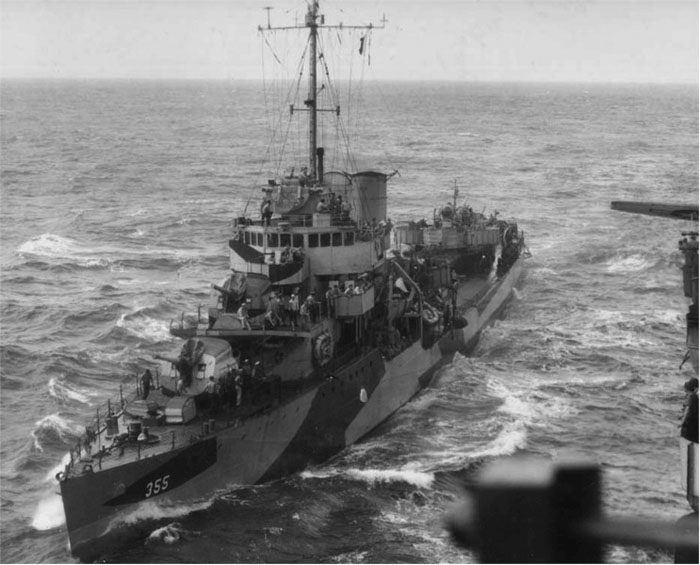
USS Alywin, possibly in late 1942 or 1943
On 15 May USS Aylwin screened Yorktown and brought TF 17 in Nukualofa Harbor (Tongatapu), transferring personal to USS Portland and rfueling from her, patrolling off the entrance before joining USS Astoria escorting USS Harriett for their voyage back home. On 28 May USS Aylwin screened Enterprise and Hornet north of Midway and on 4 June was presetn at the Battle of Midway. On 11 June seh was detached to escort the oiler USS Kaskaskia to the Aleutian Islands and TF 8. With TF 8 she screened USS Louisville and three light cruisers, six destroyers escorting them to Women’s Bay, Kodiak Island and back to Kaskaskia, and then Hawaii. She stayed in the Yard for upkeep, and departed on 2 August to screen the escort carrier USS Long Island bound for Guadalcanal. She assisted the assault on Guadalcanal, Tulagi, and Gavutu.
After the disastrous Battle of Savo Island, Aylwin brought escaping transports back to Suva, Fiji, refuelling and awaiting instructions. Shewas ordered to the New Hebrides, Vila Harbor, Efate on 17 August, then Mele Bay and with USS Dale and Helena she escorted Long Island to Guadalcanal. She was refuelled by USS Cimarron (Same type as the Sangamon class carrier). After offshore patrols at Efate she escorted Long Island to Espiritu Santo, refuelled at Pago Pago in Samoa, moved to Canton Island and escorted transports there. As part of TG 15.4 and with USS Conyngham she headed for Nouméa and Tongatapu, assigned to the damaged USS North Carolina to Pearl Harbor. In November, she escorted a convoy to Espiritu Santo.
Off Santa Cruz Islands, Vanikoro Island she protected the seaplane tender USS Ballard to Vanua Levu and back to Espiritu Santo, but developed steering issues. Fixed, she resumed ASW patrols dollowed by plane guarding USS Nassau until 22 November. From Nouméa she escorted USS South Dakota via Bora Bora, to California, herself fixed at Mare Island and departing on 8 January 1943 for Alaska with USS Bancroft and Dale.
She took part in the invasion of Attu on 11 May 1943 after many escort missions and some shelling on Kiska (8-9 July) she was back in Adak, and from there, San Francisco leaving in 19 October, screening USS Sangamon, USS Chenango, and USS Suwannee of the namesake class to the New Hebrides, Espiritu Santo and until December 1943 she screened carriers Sangamon and Suwannee at the Gilbert Islands, then with USS Bailey escorted back USS Maryland to Pearl Harbor and then escorted Tennessee and Colorado to San Francisco.
After upkeep at Alameda, USS Aylwin escorted a LST convoy from San Diego to Hawaii, Kauai and sailed to the Marshall Islands, Kwajalein. She stayed there apart a supply run to Majuro and back and then Eniwetok with USS Hall, MacDonough, and Monaghan, shelling Parry Island. Next she was assigned to TG 58.2 (USS Bunker Hill, Hornet, Monterey, Cabot, under RADM Alfred E. Montgomery). In April, it was deployed in air strikes through the Carolines. Her AA gunners fired on the 29th and 30th, later rescuing the crew of a downed Curtiss SB2C “Helldiver” from Bunker Hill. Next she operated off New Guinea for the Aitape, Tanahmerah Bay, Humboldt Bay operation and was back for supply on 4 May and short upkeep with USS Prairie.
In June she departed Majuro for the Marianas Islands with TF 58, being part of the Northern Bombardment Unit (TU 58.7.2) on North Saipan and part of the antisubmarine screen for the battleships USS Alabama and South Dakota, then back to the carriers as they refueled. She rescued two aviators from USS Bunker Hill and another lated during the bombardment of Guam. On the 17th, she was in escort mission, missing the Battle of the Philippine Sea. Back to Eniwetok on 28 June she escorted USS Wichita and St. Louis furing on Guam and bombarding installation on the northern shores herself, assigned Asan Beach. She stayed as a distant support during the night beach obstruction demolition work and later relieving USS Dewey on 21 July off Asan Beach, herself by Dale later.
She covered transports northwest of Orote Point and Agana Bay then covered a cruiser bombardment of Rota Island before going back to Eniwetok and in August, steamed back to Bremerton, Washington, for a major overhaul. She sailed back with USS Colorado and Farragut via San Pedro and Hawaii, after some refresher training to the Philippines sector with USS Baltimore, San Juan, and three destroyers. From Ulithi on 21 November she arrived on station by December 1944, missing the battle of Leyte two months prior.
On 10 December she became flagship of Commander TG 30.8 replenishment group. Captain Jasper Acuff conducted her group from Ulithi on behalf of the 3rd Fleet and met TF 38, cprotecting the refueling operations. However Typhoon Cobra soon fell on the area and USS Aylwin was found to roll 70 degrees to port, later having two Machinists swept overboard, then the chief engineer, never to be seen again. She developed a leak in her engine room at 19:30 but survived. She was repaired at Ulithi just before Christmas by USS Markab. She left Ulithi by January 1945 and went on with her replenishment group escort the next month, part of TG 50.8 with USS Crowley, Weaver, Suamico, Shasta, Wrangell. Together she reached Iwo Jima on 21 February. On the 23th she was reassigned to TF 54 fire support group replacing USS Tuscaloosa.
She was assigned the southern sector of Iwo Jima and on 23-24 February took part in the proper Battle of Iwo Jima, before refuelling at Ulithi and be prepared for operations off Okinawa, patrolling between Kerama Retto and Ulithi. She went through her second typhoon on 5 June 1945 assisting USS Pittsburgh, loosing her bow, even searching for the latter. She was back to Guam on 10 June and by 6 July sailed back to the Carolines, Ulithi and escorting Convoy UOK-39 to Okinawa. Back to Ulithi she acted as picket station B-6 on 3 August but was soon detached so search for survivors of USS Indianapolis. She only located three deriving bodies, making a burial at sea.
On 13 August she escorted troopships to the Marianas, entering Apra Harbor just before the surrender. Ordered back to Hawaii with USS MacDonough escorting the CVE USS Rudyerd Bay, she arrived in Pearl, embarked passengers and headed from the 27th to the West coast. She later left San Diego transited Panam on 20 September, and reached New York City on the 25th, decommissioned at the yard on 16 October, struck on 1 November and later sold to George N. Nutman of Brooklyn by December 1946 to be scrapped on 2 September 1948. She received 13 battle stars for her Pacific Campaign.

 Latest Facebook Entry -
Latest Facebook Entry -  X(Tweeter) Naval Encyclopedia's deck archive
X(Tweeter) Naval Encyclopedia's deck archive Instagram (@navalencyc)
Instagram (@navalencyc)





 French Navy
French Navy Royal Navy
Royal Navy Russian Navy
Russian Navy Armada Espanola
Armada Espanola Austrian Navy
Austrian Navy K.u.K. Kriegsmarine
K.u.K. Kriegsmarine Dansk Marine
Dansk Marine Nautiko Hellenon
Nautiko Hellenon Koninklije Marine 1870
Koninklije Marine 1870 Marinha do Brasil
Marinha do Brasil Osmanlı Donanması
Osmanlı Donanması Marina Do Peru
Marina Do Peru Marinha do Portugal
Marinha do Portugal Regia Marina 1870
Regia Marina 1870 Nihhon Kaigun 1870
Nihhon Kaigun 1870 Preußische Marine 1870
Preußische Marine 1870 Russkiy Flot 1870
Russkiy Flot 1870 Svenska marinen
Svenska marinen Søværnet
Søværnet Union Navy
Union Navy Confederate Navy
Confederate Navy Armada de Argentina
Armada de Argentina Imperial Chinese Navy
Imperial Chinese Navy Marinha do Portugal
Marinha do Portugal Mexico
Mexico Kaiserliche Marine
Kaiserliche Marine 1898 US Navy
1898 US Navy Sovietskiy Flot
Sovietskiy Flot Royal Canadian Navy
Royal Canadian Navy Royal Australian Navy
Royal Australian Navy RNZN Fleet
RNZN Fleet Chinese Navy 1937
Chinese Navy 1937 Kriegsmarine
Kriegsmarine Chilean Navy
Chilean Navy Danish Navy
Danish Navy Finnish Navy
Finnish Navy Hellenic Navy
Hellenic Navy Polish Navy
Polish Navy Romanian Navy
Romanian Navy Turkish Navy
Turkish Navy Royal Yugoslav Navy
Royal Yugoslav Navy Royal Thai Navy
Royal Thai Navy Minor Navies
Minor Navies Albania
Albania Austria
Austria Belgium
Belgium Columbia
Columbia Costa Rica
Costa Rica Cuba
Cuba Czechoslovakia
Czechoslovakia Dominican Republic
Dominican Republic Haiti
Haiti Hungary
Hungary Honduras
Honduras Estonia
Estonia Iceland
Iceland Eire
Eire Equador
Equador Iran
Iran Iraq
Iraq Latvia
Latvia Liberia
Liberia Lithuania
Lithuania Mandchukuo
Mandchukuo Morocco
Morocco Nicaragua
Nicaragua Persia
Persia San Salvador
San Salvador Sarawak
Sarawak Uruguay
Uruguay Venezuela
Venezuela Zanzibar
Zanzibar Warsaw Pact Navies
Warsaw Pact Navies Bulgaria
Bulgaria Hungary
Hungary

 Bundesmarine
Bundesmarine Dutch Navy
Dutch Navy Hellenic Navy
Hellenic Navy Marina Militare
Marina Militare Yugoslav Navy
Yugoslav Navy Chinese Navy
Chinese Navy Indian Navy
Indian Navy Indonesian Navy
Indonesian Navy JMSDF
JMSDF North Korean Navy
North Korean Navy Pakistani Navy
Pakistani Navy Philippines Navy
Philippines Navy ROKN
ROKN Rep. of Singapore Navy
Rep. of Singapore Navy Taiwanese Navy
Taiwanese Navy IDF Navy
IDF Navy Saudi Navy
Saudi Navy Royal New Zealand Navy
Royal New Zealand Navy Egyptian Navy
Egyptian Navy South African Navy
South African Navy






























 Ukrainian Navy
Ukrainian Navy dbodesign
dbodesign